






















































































































































































































CITY SLICKER Coast-to-coast with Suzuki’s GSX-S1000GT TOP TIPS for tackling towns and cities (the sweet life) IT’S SHOWTIME! YOUR 16-PAGE GUIDE A love letter to MV Agusta’s 750S America from the 70s THE INTERNATIONAL CLASSIC MOTORCYCLE SHOW / APRIL22-23 Bringing YOU the BEST of biking for FREE ★WIN! ★ WIN! ★WIN! ★ W I !N ★W W !N ★ W I N! WORTH OVER £500 SHARK HELMET
INSPIRING RIDES

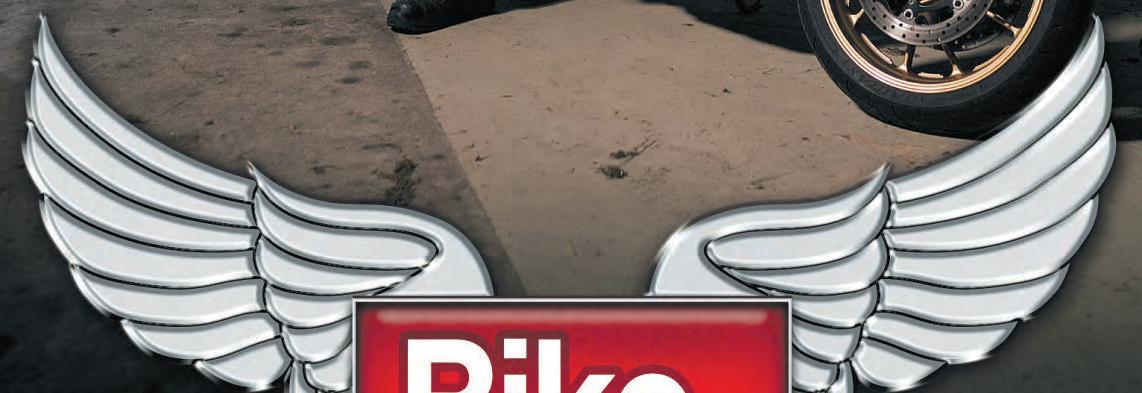





It’s been a good ’un this month. The weather's been pretty decent, and we’ve had plenty of dry days to put a whole host of bikes through their paces. I had a cracking day hitting the trails on Herald’s Maverick 250 (full review coming next issue); got the chance to ride Suzuki’s new V-Strom 1050s over in snowy Greece (first impressions on page 18); and endured a wintery slog to pick up a new passport on Kymco’s DTX 360 320 (it’s bloody good, by the way).

I also put BSA's new-ish Gold Star
Editor

650 through its paces against the Royal Enfield Interceptor 650 (for a road test for our good pals at Motorcycle Sport and Leisure magazine). If they get the dealer network right, I reckon the new BSA could tempt its fare share of punters to make the leap from Enfield. What do you reckon? Would you have one? The calendar’s quickly filling up with plenty of cool biker events we’re planning to visit. We want to get out and about as much as possible this year, so if you see a ragtag group of bikers armed with a stack of papers and a bundle of
stickers, be sure to collar us for a natter on all things bikes and blag a freebie.

First up is the big International Classic Motorcycle Show at Stafford (April 2223). A mecca for lovers of old bikes, we’ll be the ones slap-bang in the middle of the main hall getting funny looks for bringing a new bike or two along to the party. If you’re going to be there, come and say hello. Until then, ride safe.







FIRST IMPRESSIONS
A
Editor MB recommends bikesafe.co.uk MoreBikes, Media Centre, Morton Way, Horncastle, Lincolnshire LN9 6JR Tel: 01507 529529 Editor Ross Mowbray Editorial design Fran Lovely Publishing Director Dan Savage Email editorial@morebikes.co.uk Production Editor Mike Cowton Group Advertising Manager Sue Keily Advertising Simon Meyer 01507 529310 Advertising deadline for May issue May 6, 2023 Sales and Distribution Manager Carl Smith Marketing Manager Charlotte Park Commercial Director Nigel Hole Customer services number 01507 529529 Telephone lines are open Monday-Friday 8.30am-5pm Call 01507 529529 or visit classicmagazines.co.uk/MB10 or email subscriptions@mortons.co.uk MoreBikes is published monthly by Mortons Media Group Ltd and printed by Mortons Print. Subscribe to MB and just pay the postage! INSIDE THIS MONTH HOT STUFF 59 13 18 15 APRIL 2023 KNOW IT ALL? Test your biking knowledge with the MoreBikes Quiz MoreBikesEvenMoreBikesOfficialMoreBikes Ducati Diavel V4 £23,595 of three of the best new bikes of 2023 Suzuki V-Strom 1050 DE £13,855 Royal Enfield Super Meteor £6799 NEWS 3
nod from the
HUSQVARNA NORDEN 901 GETS EXPEDITION-READY

Husqvarna has just released a new, trick version of its Norden 901 adventure bike – and it’s fitted with a whole host of additional goodies to make it better suited to racking up the big miles and having a proper explore.
First revealed in prototype form back in 2019, the Husqvarna Norden 901 had plenty of potential punters drooling, thanks to its blend of good looks and its tried-and-tested KTM 890 Adventure base. And by the time it was actually released in 2022, we couldn’t wait to get our hands on one and go for a spin. The bike impressed – with testers far and wide praising its ability both on- and off-road (even it maybe wasn’t quite as dirt-focused as initially expected).
Now Husqvarna’s decided it’s time to take things further, with a host of tweaks and additional extras to improve the already brilliant base bike. Firstly, the WP APEX suspension has been swapped out for fully adjustable WP EXPLOR units (with an increased 240mm of travel at both the front and rear); there’s a new taller touring windscreen; heated grips; and a heated seat as standard. There’s also a soft luggage set thrown in, which offers 36 litres of storage space, a centrestand and a sleek new paint job, too. Not bad, right?
Away from the changes, the Norden 901 is unchanged. It’s still powered by the same KTM-derived 889cc parallel-twin engine, which kicks out 103bhp and 74lb-ft of torque – and there’re still four riding modes (Street, Rain, Offroad, Explorer) and switchable ABS to play with.
Tempted? The Husqvarna Norden 901 Expedition is available now for £13,599. It’s not cheap, coming in at £1000 more than the ‘standard’ machine, but you do get some very useful kit that will help make the bike even better than before.
HYDROGEN FUTURE?
Honda team up with General Motors
Honda and General Motors are the latest firms to reveal plans to get stuck into some hydrogen fuel cell research – and we’re here for it.
With the increasingly urgent need for emissions-free vehicles, we’ve started to see more and more battery-powered machines making it to market. But there’s still a lot of scepticism among bikers about the plausibility of electric (particularly for those making longer journeys).
Thankfully, it looks like there might be another option – because Honda and General Motors have announced that they’re throwing some resources into exploring what can be done with hydrogen.

Hydrogen’s magic stuff. It’s plentiful and has almost three times the energy density of fossil fuels. But it’s pretty difficult to harness. That said, Honda and GM already have plans to release a CR-V four-wheeler powered by a hydrogen fuel cell next year – and we’re hoping this technology makes it into a two-wheeler very soon.
Toyota’s come up with replaceable hydrogen fuel-cell cartridges, which can be safely used, refilled and slotted into place, similar to some of the battery swapping tech we’ve seen in recent years. Kawasaki’s been looking into using pressurised gas canisters (stashed in some panniers) to power a supercharged engine based on the Ninja H2. TVS has also submitted
a patent for a scooter with two removable hydrogen canisters tucked into the front fairing.
With hydrogen power getting plenty of attention from some big motorcycle and scooter firms, it’s looking increasingly likely that an alternative to battery-powered bikes will be coming in the not-too-distant future. Good stuff
Peugeot’s XP400 Allure and GT are the latest scoots to get in on the adventure act – with rugged styling (and even off-road tyres for the GT) similar to Honda’s ADV350 and Kymco’s DTX360 320.
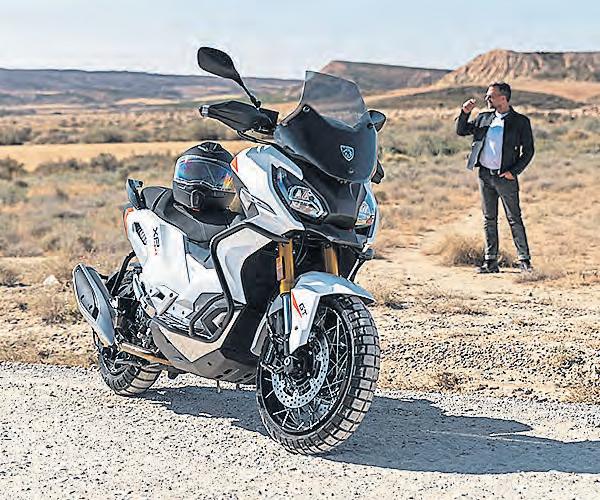

The biggest scooters in Peugeot’s range, they’re powered by a 400cc single-cylinder engine which kicks out a respectable 36.7bhp and 28lb-ft of torque. They’re also both equipped with a motorcycle-style 17-inch front wheel and a 15-inch rear (which are wire-spoked numbers on the GT). Suspension comes in the form of some chunky upside-down 41mm front forks and
a combined hydraulic rear spring. Stopping is looked after by a pair of 295mm discs up front, while a single 240mm disc takes care of things at the rear. There’s also dual-channel ABS and traction control thrown in. Add a colour TFT dash (with full connectivity), LED lights all round, a USB port and under-seat storage (to stash a full-face helmet), and Peugeot could be onto a winner.
Coming in at £7249 for the XP400 Allure and £7349 for the XP400 GT, they’re bang on the money when compared to the competition – and based on our previous experience of Peugeot scooters, they will be well worth a closer look.
PEUGEOT’S SUV SCOOTER
4 NEWS
The French firm is ready to challenge some stiff maxi-scooter competition


TRANSFORM YOUR TÉNÉRÉ
Rally Raid’s built up an enviable reputation among those who know about adventure bikes, and has had plenty of success with its aftermarket upgrades to the ‘standard’ Ténéré 700 – including kitting out the bike that Pol Tarrés hoons around on in those insane videos that’ve been doing the rounds over the past couple of years. And Yamaha were so impressed that they actually asked Rally Raid for one of its rear shock units for its World Raid prototype.
That means Rally Raid was pretty well placed to make a start on improving the already excellent World Raid version of the T7. And the first thing on the list was (you guessed it) suspension. Getting into specifics, Rally Raid replaced the shock’s stock T7’s 20mm diameter piston in favour of a much chunkier 35mm unit. It reckons that translates to more controlled damping, helping the bike handle big bumps and jumps even better. There’s also a hydraulic end stop to reduce the impact at the end of the forks’ travel.
That’s not all, as Rally Raid also has been working with TracTive Suspension in the Netherlands to create a matching rear shock that’s just as capable. It uses a dual piston set up – which is essentially a 46mm main piston with 16mm rod, with a smaller second piston sitting on top. As the shock begins to bottom out, the second piston enters the housing, thereby increasing the damping resistance without mechanically overloading the shock. Pretty clever, right?
Of course, you’ll have to fork out (excuse the pun) a good whack of cash to get your hands on the Rally Raid kit. Available with both standard travel and -25mm travel, the fork kit costs £1199 and the rear costs £960.
That’s a just over a couple of grand extra, which is pretty hefty, but ultimately if you’re planning to properly put your T7 World Raid through its paces in the dirt, it’s going to be well worth the investment.
If you want to know more, or you’re interested in checking out Rally Raid’s fairly extensive range of off-road and adventurefocussed goodies, visit: www.rally-raidproducts.co.uk
STRAIGHT TO YOUR DOOR
The resurgent British firm has just announced a cool new service which offers the chance to get a brand-new £16,499 Commando 961 Sport or £16,999 Commando Café Racer straight to your door for a test ride.


Since being taken over by Indian automotive giant TVS, things are on the up at Norton Motorcycles. The bikes are being built, the bosses are making the right noises, and early reviews have been good. But there’s still a bit of an issue with the amount of dealerships where you can actually go and check out a new Norton in the flesh. That’s why the firm has come up with a clever idea to make it easy for potential punters to swing their leg over one of the new Commando’s. Okay, so it’s only good if you’re living on the UK mainland, and you will have to pay a 10% holding deposit for the privilege (in addition to a fuel charge based on your distance from Norton’s Birmingham HQ), but you will get to test ride one of the new machines in
your own backyard. And if you decide the bike’s not for you, you will get your holding deposit no questions asked. Initial response has been extremely positive, so you’ll likely have to wait a few weeks to get one delivered, but credit to Norton for finding a novel way to get bums on seats and drum up a bit of interest for its new machines while it’s still finalising the dealer network. For more information, simply head to the Norton website.
Royal Enfield has just announced its going to be continuing to offer awesome motorcycling trips with the help of Vintage Rides, until at least the year 2025.

Vintage Rides knows the game well, having undertaken more than 1000 guided tours on Royal Enfield bikes since 2006. They’ve been to France, Italy, Argentina, Morocco, Mongolia and plenty of places in between.
In the next couple of months alone they’ve got tours planned in India, Sri Lanka, Nepal, Peru and Vietnam – with a whole host of choice depending on whether you want to rough it or live it up in comfort. As you’d expect, prices
aren’t cheap – and you can expect to be paying in excess of £2000 per rider. But if riding in some far-flung countries is your bag and you’ve not got months or even years to plan the trip, then you’d be wise to give the guys at Vintage Rides a look in.
Speaking about the announcement, Mohit Dhar Jayal, RE’s Chief Brand Officer, said: “This collaboration is a step toward ensuring that our riders will be able to ride our motorcycles on some of the most breathtaking adventures across the world.”
If you want to find out more, check out: www. vintagerides.travel
Norton’s new service aims to make it a doddle to test ride the new Commandos. Here’s how
EXPLORE THE WORLD WITH ROYAL ENFIELD
6 NEWS
Adventure experts Rally Raid has worked its magic on the recently released Yamaha Ténéré 700 World Raid – with some serious suspension upgrades to make it even more capable off-road



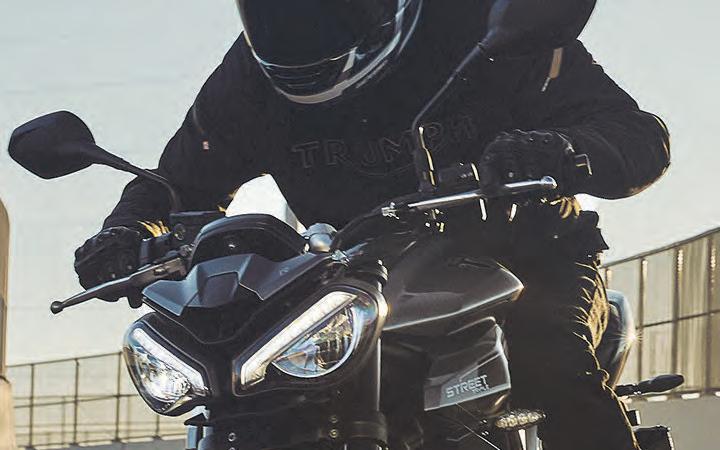


SUZUKI EXITS BRITISH SUPERBIKES
There’s another race series which won’t be getting any factory support from Suzuki: British Superbikes.

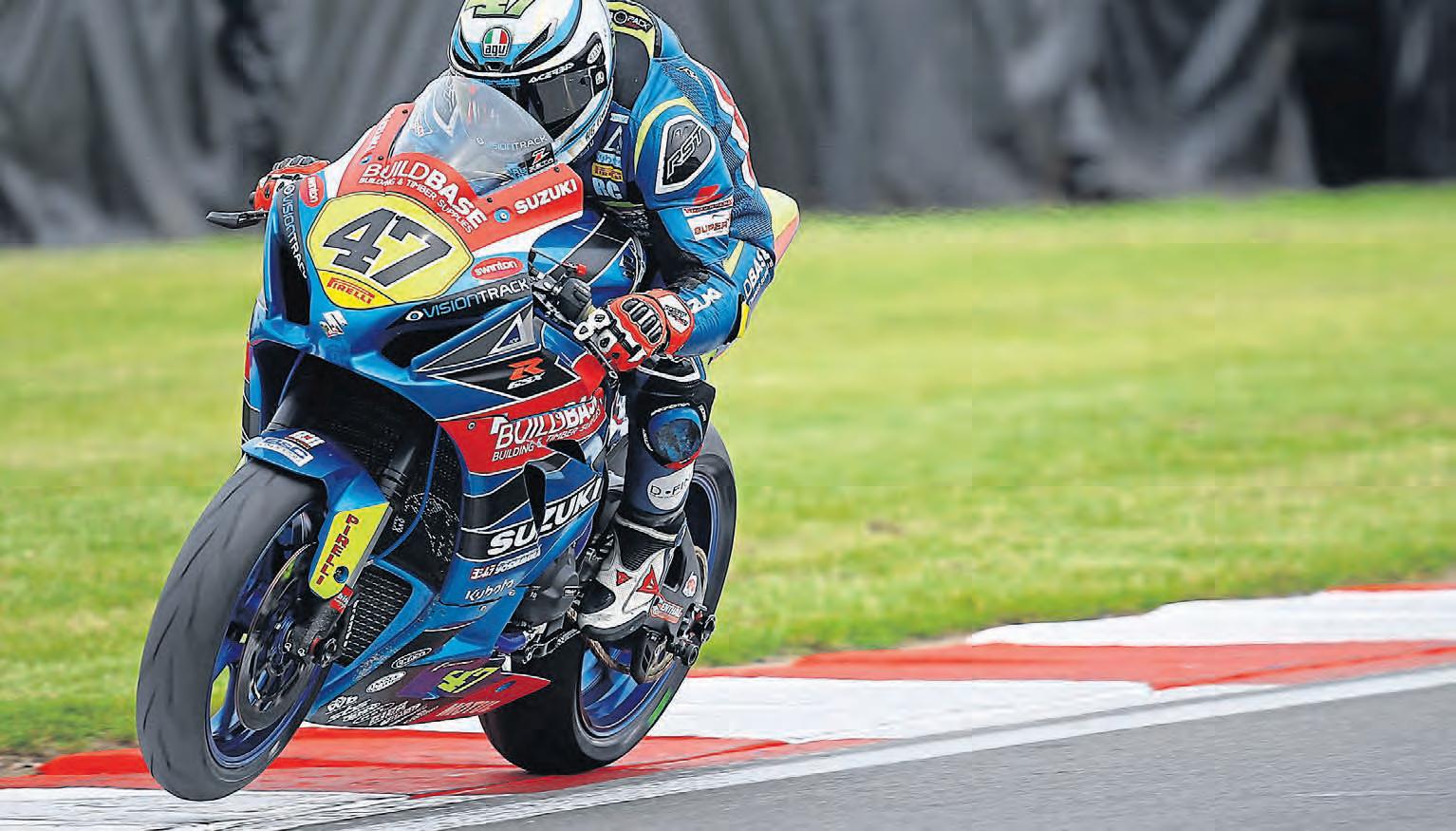












That’s right. Following on from the news that Suzuki’s leaving MotoGP and dropping factory support for the Endurance World Championship, it’s now been revealed that it is departing from the British Superbike Championship for the 2023 race season.





















The news followed Hawk Racing’s reveal that it’s splitting from the brand. It’s been working with Suzuki in an official capacity since 2017 – but not any longer. Hawk will now be running Honda CBR1000RR-Rs for 2023.


The race team stated that the split was as a result of the ‘manufacturer’s recent announcements about its racing activities globally, and the absence of news about the possibility of a new GSX-R1000’, while Suzuki added that its future absence from the paddock BSB was in line with the brand’s ‘global racing strategy’.


Strange times. Of course, it’s hugely expensive to go racing – and there has been talk that the Japanese firm is throwing its money into other avenues as it looks towards the future of motorcycling. Thankfully, Suzuki has confirmed it will continue to provide support for those running Suzuki machinery, with its Race Parts Programme, which is surely a relief to many.




8 NEWS
WIN A SHARK SPARTAN GT PRO
We’ve teamed up with our friends at Nevis Marketing to offer MoreBikes readers the chance to WIN a Shark Spartan GT Pro! Brand-new for 2023, the ECE 22.06 compliant Shark Spartan GT Pro is the next generation of the much-loved Spartan GT. It’s a well-equipped bit of kit, featuring an aerodynamically designed outer shell made from a combination of carbon fibre and multiaxle layers with a multi-density EPS.
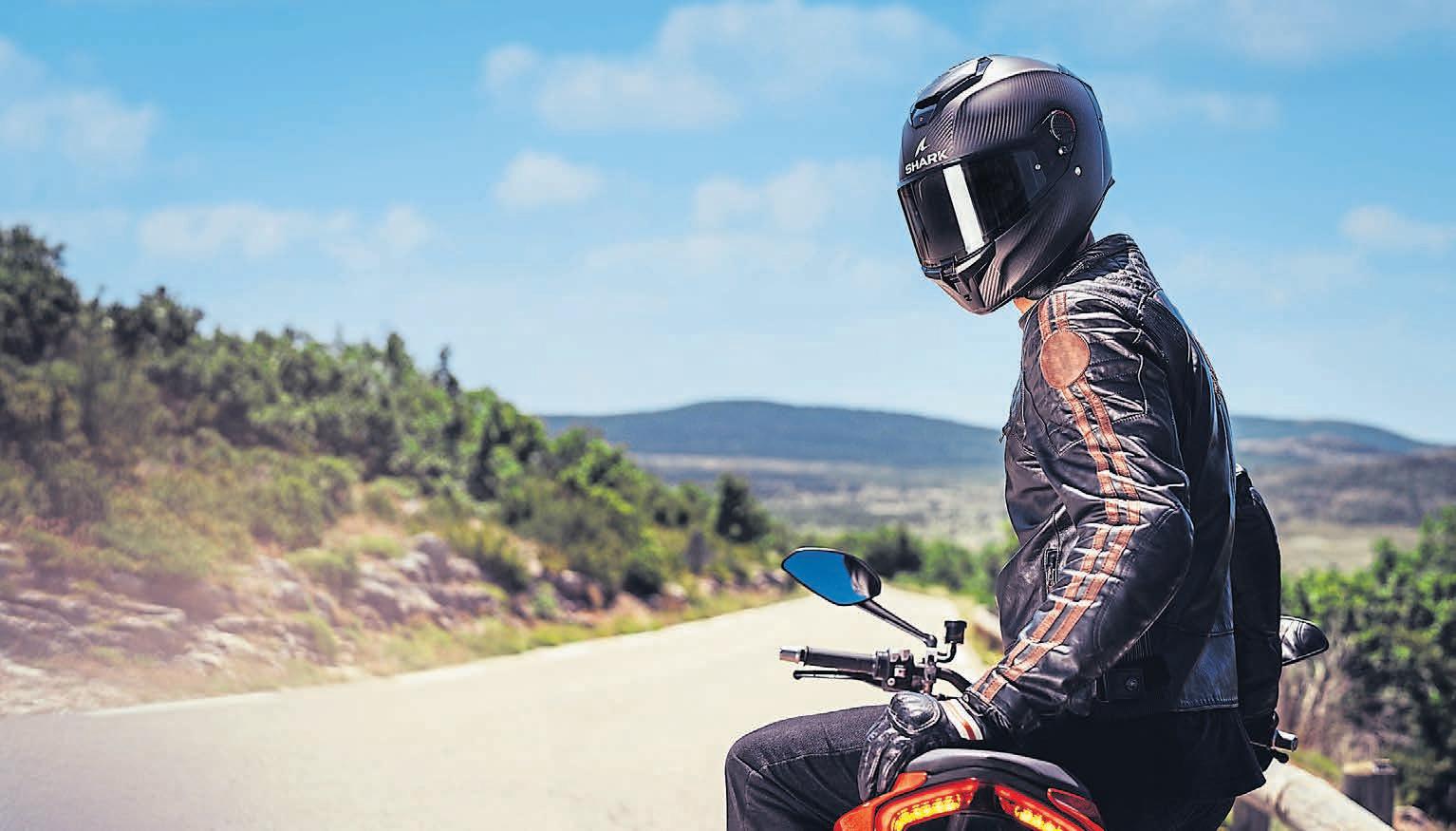
There’s a VZ300 Class 1 rated visor which is designed for clear vision (as well as to protect riders from any projectiles in the event of an accident), and the four-point visor locking system has been taken from the top-of-the-range Race-R Pro GP helmet. Every detail has been designed to limit noise, too, with ventilation optimised and adjustable thanks to the three inlet vents and two Venturi-effect outlets.
The Shark Spartan GT Pro is available in 15 colourways (including six carbon variants) and is priced from £429.99 right up to £509.99. And best of all, the winner will be able to choose the exact one they want.
HOW TO ENTER









1. Head to www.morebikes.co.uk

2. Visit the competition section of the website









3. Fill in the form for your chance to win!
Competition closes at midnight on April 21, 2023. There are no cash alternatives available. The winner will be the first name drawn at random. Winners will be contacted via an official Mortons email. We never ask for bank details. Terms and conditions apply. To view the privacy policy of MMG Ltd (publisher of MoreBikes) please visit www.mortons.co.uk/privacy
WORTH OVER £500
COMPETITION 9
BRITISH SUPERBIKE CHAMPIONSHIP

ROUND ONE / APRIL 7-9 / SILVERSTONE CIRCUIT / www.britishsuperbike.com




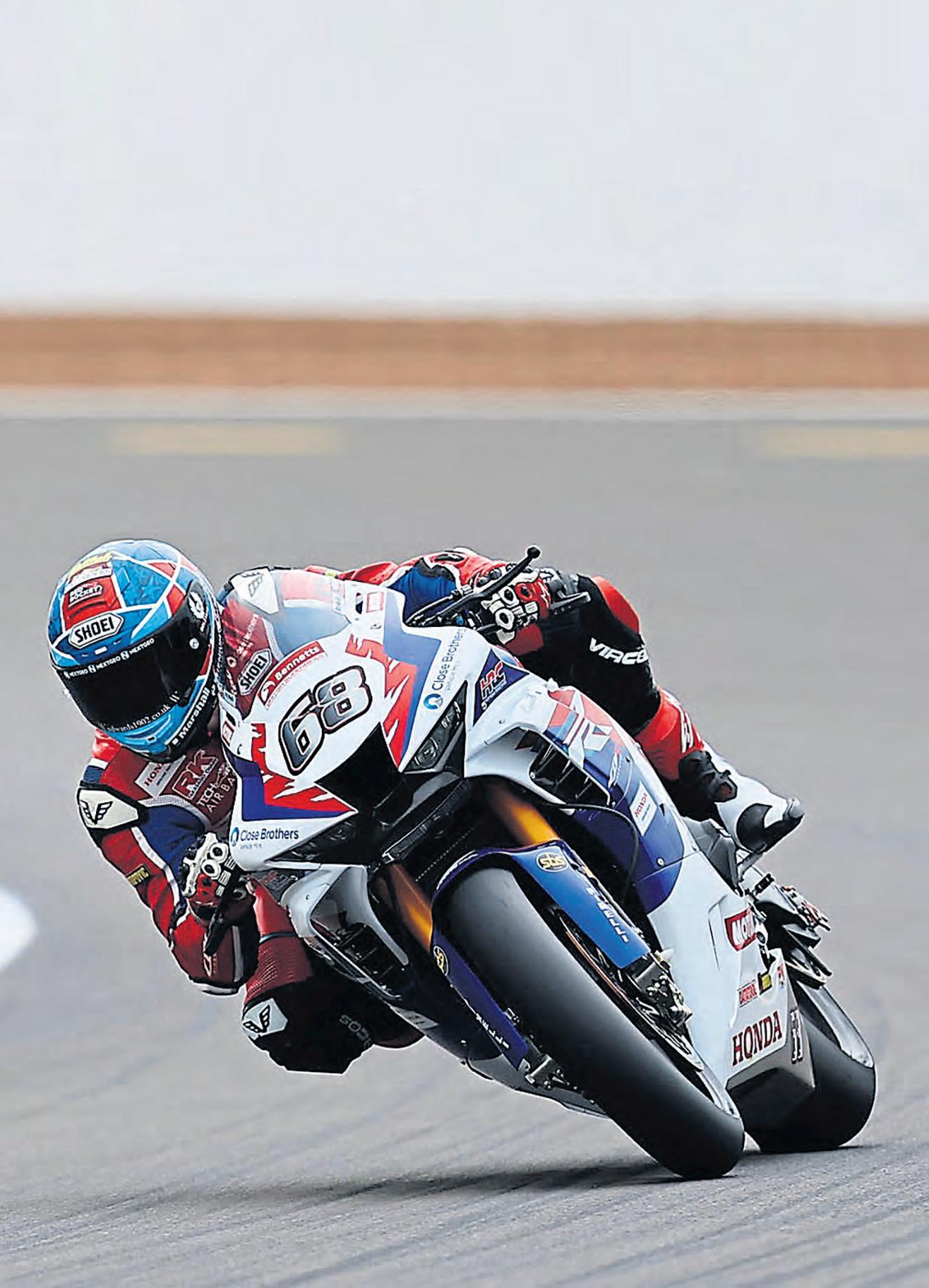
It’s been a long old wait through the winter, but with testing done and dusted, it’s finally time for the opening round of the British Superbike Championship. And we can’t wait!
Silverstone has been home to the BSB season opener for years, and 2023 will be no different. We’re expecting to be treated to some fast, frantic action as some of the best riders in the game go head-to-head on the National circuit.
10 EVENTS
Q&A
Our specialist motoring solicitor Andrew Prendergast guides readers through their legal trials and troubles
QI was riding through my village when suddenly this young lad bolted out in front of me off the pavement. It turns out he was making a bloomin’ video for You-Tok or TikTube or some other nonsense with his mate. (Yes, I know I sound like a grumpy old bastard… because I am!) I properly hit him, and I thought he was seriously done for. Luckily, he bounced pretty well and both he and I got up off the floor pretty much unscathed. However, my threeweek-old Triumph Rocket 3 on the other hand was not so good. After I hit him, I wobbled near enough to a stop but then fell over. I have a quote of £3,377.21 to fix it. I am now pondering whether to claim off my fully comprehensive insurance policy or go after the lad. As everyone knows everyone in my village, I know he’s about 20 years old and lives with his nan after his mum and dad split up. I also know he hasn’t got too much in the way of cash as he has just started an apprenticeship as a carpenter. My insurer is trying to put me off claiming from them, saying it will affect my no-claim bonus. They said they will put me in touch with a third-party company at no cost to me and I will get a free hire bike, etc. However, I’ve read online that some people
have been proper stitched up by this company. What should I do?

AI am getting more and more calls of ‘helpful’ insurers trying to put their customers off from claiming from them. In short, you have paid your money to insure a risk. If that risk happens, i.e. your Triumph gets trashed, then your insurer should pay out for that risk, if you want to claim. It’s as simple as that. Whilst your no-claim bonus will be affected, your bike should be repaired and back on the road sooner rather than later. Alternatively, you could go after the lad, and you may even win 100%. However, if he hasn’t got a pot to piddle in, you will either never get your money; or it will take him several years to pay it. Neither is good for the speedy repair of your bike. As for the third-party company, you’re right to question their motivations. There is no such thing as a ‘free lunch’ as they say, and they make their money off recovering/storing and hiring bikes, etc. If you sign paperwork that says you’re liable for these costs, and they do not recover their outlay from the lad, guess who they will be coming after? You guessed it, you. One of the worst cases I have seen is a £17,000 storage/
hire case when the bike had about £500 worth of damage. In my view, it was scandalous and a lot of stress for the poor biker who they were chasing for money after they didn’t get it from the third party.
QMy brother isn’t a bad man. However, it is fair to say he’s a trouble magnet and ever since we were kids his problems inevitably became my problems. Despite knowing this (and I am kicking myself as I am writing this) I felt sorry for him as he had crashed his ZX-10R on a track day last summer. Following this my ever-lovely brother wanted to borrow my bike (also a ZX-10R), told me that he had insurance, and I presumed he was telling the truth. However, about a week later he ran into the back of an old Fiesta waiting at traffic lights. How, I do not know. Thankfully, no one was hurt. However, the Police were behind him and stopped to help. Unfortunately, it transpired my dipstick brother didn’t have any insurance and quite rightly he is now getting done (as well as having to pay for the Fiesta and my bike). The problem I have is I am also now getting done for letting him ride the bike with no insurance. I’m thinking that I
The MB legal column is compiled by managing partner Andrew ‘Chef’ Prendergast and his bike-riding barristers and solicitors at White Dalton Motorcycle Solicitors.

The firm deals with personal injury claims and its sister company, Motor Defence Solicitors, deals with all the motoring offences. White Dalton lawyers have a vast knowledge of bike law, and they have full bike licences, too. They don’t act for insurance companies or the prosecution.
White Dalton is Britain’s premier specialist motorcycle law practice, and if its professionals don’t know the answer

must have a defence. I was insured if I rode the bike but it’s only his problem if he isn’t insured, isn’t it? Please help.
AThankfully, no one was hurt. At best your brother is a careless idiot and at worse he is just plain reckless in riding around without insurance. Plus, he’s now dragged you into his mess. As for your question, I am genuinely sorry to advise you do not have a defence. Unfortunately, even though you personally had insurance, as you let your brother out on your bike without properly checking he was insured to ride, i.e. by looking at the certificate, then you are guilty of permitting him to ride without insurance. The law relating to insurance is very strict. As such, my advice would be to plead guilty and try and obtain the lowest sentence possible. When it comes to putting forward mitigation, be very careful what you tell the Court. Depending on exactly what your brother told you and what you knew, etc., it may well help in mitigating the level of sentence you get. However, if your explanation just highlights you have been careless/lazy, etc., in checking, then it may well harm your position.
to your question, there probably isn’t one. Don’t rely on the advice from your insurance-appointed solicitor, get proper independent advice.
For road traffic offences, call the Motor Defence solicitors on 0800 280 0912. For non-offence cases, call White Dalton motorcycle solicitors on 0800 783 6191.
If you need advice on a biking-related legal question or query, email mail@whitedalton. co.uk. The best Q&A will be published in MB, in confidence, of course.

S O L I C T O R S www.whitedalton.co.uk
WHITE DALTON 11
Alpinestars Faster 3 Drystar Riding Boots
£169.99 / www.alpinestars.com



As we go to press it’s a bit nippy for short riding boots, but the sun will soon be back – and these new Faster 3 urban riding boots look like just the job. There’s a microfibre upper with armour on the malleolus, heel and toes, and extensive comfort padding around the ankle and tongue area. The sole is a tough, lightweight rubber compound with built-in shock absorption, plus an integrated support shank for more rigidity. There’s traditional lace fastening, plus Velcro security strap, shift protector and an external toe slider panel. Best of all, there’s a Drystar waterproof, breathable membrane for those spring showers.
Tucano Urbano Bormio jacket
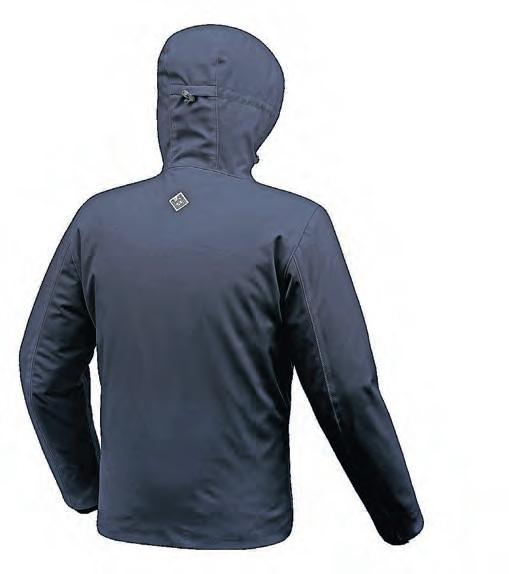
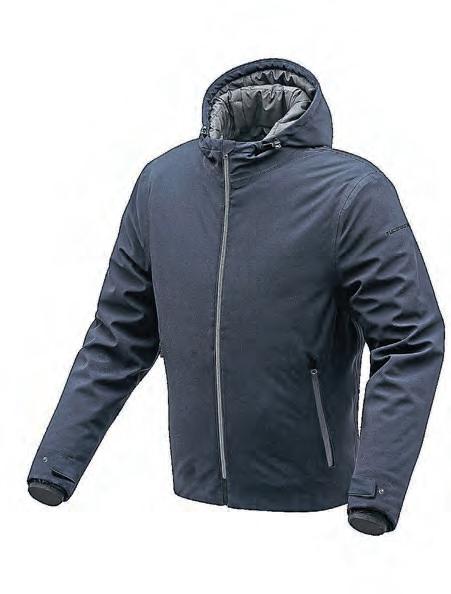
£159.99 / www.tucanourbano.com/en/
We’ve tried out some of Tucano Urbano’s urban riding kit over the years and it’s stylish, well-made stuff. This Bormio jacket looks good on and off the bike, but is also fully featured, with a laminated
Oxford Polar 1.0 MS Winter Gloves


£49.99 / www.oxfordproducts.com

As all hardcore winter riders know, you can’t beat a ‘lobster claw’ two-finger glove when the weather turns really bad. It’s something to do with surface area and volume, but whatever the science says, they just work. Oxford claims these Polar 1.0 MS gloves are its warmest ever, with Primaloft thermal lining; Dry2Dry waterproof breathable membrane; leather and nylon construction; and reinforced seams. There’s a touchscreen compatible forefinger and thumb; a built-in visor wipe; synthetic suede bar gripping panels; Velcro wrist and cuff straps; and much more. Just the job for those long winter commutes.
It’s pre-wired for the IN&MOTION airbag set up as well. The Bormio is packed with pockets and adjusters; has a thumbloop inner cuff to stop draughts; waterrepellent zips; padded thermal/fleece lining; adjustable hood; and much more. Available in sizes S-3XL in black, dark blue and white colourways.

Laser Tools Multi-Function Jump Starter

£119.94 / www.lasertools.co.uk

Cold weather doesn’t help batteries, so don’t be left in the lurch this winter! This Multi-Function Jump Starter from Laser Tools (part number 7405) is an efficient and extremely compact emergency engine starting power pack. It features a bright LED to illuminate the work area (flashing mode can be used as an emergency beacon); two USB outputs (for charging mobile phones, etc.); a Type-C input/output port; and a digital voltage display on the cable clamp adaptor. The unit and accessories are supplied in a convenient and protective case.
The unit is charged from a suitable USB port on a PC, taking three hours to fully charge, showing you the level of charge on the display. Handy… When needed, you simply connect and start the car or bike. The Multi-Function Jump Starter will start diesel engines up to 3.5 litres and petrol engines up to 4.5 litres… so bikes will be no problem!
Oxford Products Leverlock Alarm
£59.99 / www.oxfordproducts.com
Yes, it’s the splendid LeverLock design but now with an ear-splitting 120dB alarm siren. This is a highly-visible security device which, when armed, you can leave it ‘silent’, and will sit over your throttle and brake lever. If armed, it’s movementsensitive and will go off – so be wary of the cat… We love these. Cheap as chips, too!

✪
PRODUCTS ✪ PRODUCTS ✪
12 PRODUCTS
We love a bit of trivia here at MoreBikes. No matter whether we’re at a pub quiz with a beer in one hand and a pencil in the other, or being questioned by our mates when we’re stood around at a bike night, there’s something about knowing the answer to an unexpected question that
It’s time to get out your pens and pencils and put your grey matter to the test
gives us a nice fuzzy feeling inside. And if we don’t know, then there’s a good chance we might learn something. That’s cool, too. That’s why we’ve decided to introduce a regular quiz section sponsored by our good pals at Fowlers (who’ll be supplying the prizes).
We’ll be asking you questions about all manner of two-wheeled stuff,
pushing your memories to the limit and asking you to dig deep to try and remember all manner of strange stuff from right across the world of bikes. It’s a chance for you to show off your infinite two-wheeled wisdom and be in with a chance of winning some cool prizes, or if not, learn a few things that you might not know.
Worth £139.99
Which racing circuit has held the BSB opener in recent years?
For which factory did Agostini claim the GP crown in 1975?
2 5
What’s the name of Royal Enfield’s CEO?
7
In which year did MV Agusta build its first ‘MV branded’ motorcycle?
8 3 9
When was Suzuki’s much-loved V-Strom first launched?
Ducati’s latest Diavel shares an engine platform with which bike?
6 1 10 4
Who claimed the Grand Prix 500 crown in 1974?
How did BSA’s iconic Gold Star get its name?
How many Yamaha TMAXs have been sold since its launch in 2001?
Looking for a comfortable, casual jacket that’ll look as good off the bike as on it, which provides all the protection you’d need to keep you safe on the road? Then how about this armoured hoodie from Weise. Fitted with CE-armour on the shoulders, elbows and back, and a full 250-gram Aramid fibre lining, the AA-rated jacket packs plenty of protective punch and looks good while doing it. If you want to know more, then visit: www.weiseclothing.com
To be in with a chance of winning, all you’ve got to do is jot the answers down on the entry form, and send it in using the details provided. We’ll then pick the winner from an upturned helmet crammed with correct answers and that person will be sent an AArated Weise hoodie packed with plenty of protective punch. It’s that simple. So, what are you waiting for? Get cracking for the chance to win. Good luck!

COMPETITION 13 Here’s the legal bit that you need to know Fill in your details on the form or enter online and return to: MoreBikes, Weise Stealth Hoodie, 2023 Competition, Mortons Media Group Ltd, Morton Way, Horncastle, Lincs LN9 6JR. Competition closes: May 12, 2023. ANSWERS: 1.......................................................................... 2. .................................................................................. 3. ............................................................................. 4. ........................................................................ 5. .................................................................................. 6. ............................................................................. 7. ........................................................................ 8. .................................................................................. 9. ............................................................................. 10. ...................................................................... Mr / Mrs / Miss / Ms (please circle) First name:...................................................................................... Surname:............................................................................................................................... Address:....................................................................................................................................................................................................................................... Town/City:........................................................................ County:.......................................................... Postcode:.................................................................... Email:............................................................................................................. Telephone:............................................................................................................ There are no cash alternatives available. The winner(s) of the Weise Stealth Hoodie will be the first name(s) drawn at random from the upturned MB helmet. YOU can also ENTER online! Just check out the MoreBikes social media channels for more information. Terms and conditions apply. To view the privacy policy of MMG Ltd (publisher of MB) please visit www.mortons.co.uk/privacy Did you get ‘em right? 1996, 207bhp, Triumph Speed Triple, MIPS, Percy Tait, 100,000000, £90,000, 1974, 8, Moto Morini Which BSB team has just switched from Suzuki to Honda? THE WIN! HOW TO ENTER LAST MONTH
QUIZ MOREBIKES
✂









































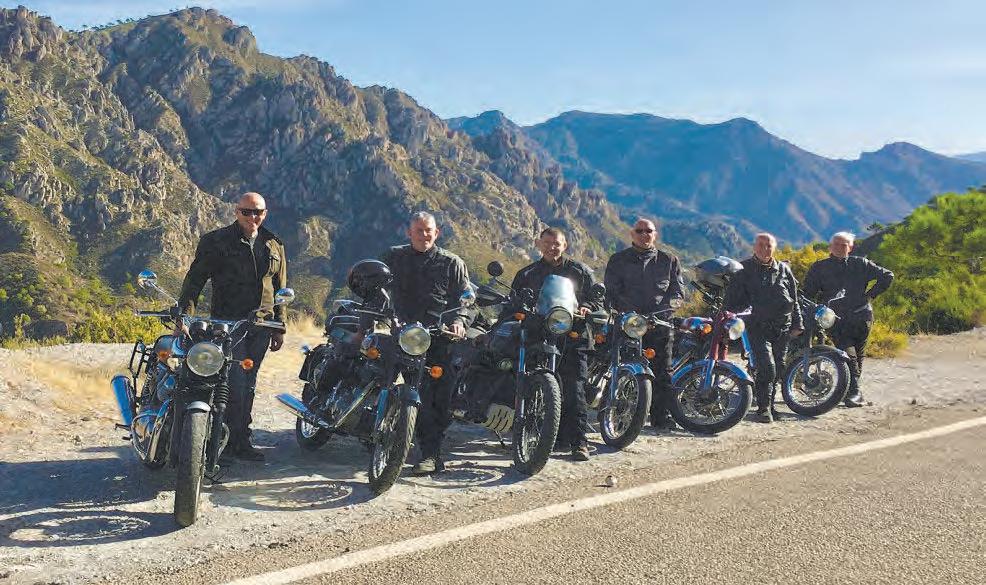




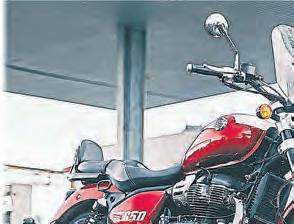

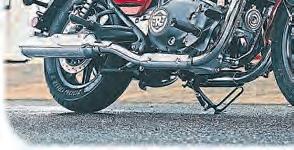


FIRST RIDE: ROYAL ENFIELD SUPER METEOR 650 15

EASY RIDER
Royal Enfield has added a cruiser to its range of wildly successful 650 twins – and we’ve been out to India to ride it.
Words: Alan Cathcart

Photography: Royal Enfield/Jason Critchell and Chippy Wood
Want to get the full lowdown on the new Royal Enfield Super Meteor 650? Grab yourself a copy of MSL and read an in-depth review from legendary road tester Alan Cathcart.
16 FIRST RIDE: ROYAL ENFIELD SUPER METEOR 650
TECH SPEC ROYAL ENFIELD SUPER METEOR 650
Engine: Air-/oil-cooled SOHC 648cc dry-sump parallel-twin four-stroke with four valves per cylinder, 270-degree crank, gear-driven counterbalancer and central chain camshaft drive, 9.5:1 compression ratio, Multipoint sequential Bosch fuel injection with dual 34mm Mikuni throttle bodies, 6-speed with gear primary drive
Power: 34.6kW/47PS/46.33bhp @ 7,250rpm (at crankshaft)
Torque: 52.3Nm/38.57lb-ft @ 5,650rpm (at crankshaft)
Chassis: Composite steel open cradle duplex spine frame with engine employed as fully stressed member, 27.6° head angle, 118.50mm trail
Suspension: 43mm Showa Big Piston telescopic fork with 120mm of wheel travel (F), box-section steel swingarm, Showa shocks, 101mm of wheel travel with 5-stage preload adjustment (R)

Wheelbase: 1500mm
Brakes: Front: 320mm steel disc with twinpiston floating ByBre calliper, Bosch ABS (F), 300mm steel disc with twin-piston floating ByBre calliper, Bosch ABS (R)
Wheels/tyres: Front: 100/90-19 CEAT Zoom
Cruz 57H on 2.50” forged aluminium wheel (F), 150/80-16 CEAT Zoom Cruz 71H on 4.50” forged aluminium wheel (R)
Seat height: 740mm
Fuel capacity: 15.7 litres
Weight: 241kg with oil and 90% full fuel tank (230kg with oil/no fuel)
Warranty: 3-year unlimited mileage
The Super Meteor 650 is available in two versions targeting different slices of the middleweight cruiser market – and they’re both powered by the same proven 648cc parallel-twin engine which made its name in the Interceptor and Continental GT.
Showa has now replaced Gabriel as suspension supplier for Royal Enfield’s twins; there’s a 19-inch forged aluminium front wheel and 16inch rear, shod with Indian supplier CEAT’s new Zoom Cruz tubeless tyres especially created for the Super Meteor, replacing the Pirellis fitted to the two existing Royal Enfield twincylinder models. Braking is supplied on the Super Meteor pair by the same single 320mm front disc as on the earlier 650 models, gripped by a twinpiston calliper from Brembo’s Indian subsidiary ByBre, and dual-channel Bosch ABS is fitted as standard.
The standard Roadster version is claimed to weigh in at 241kg with oil and a 90% full 15.7-litre fuel tank, equating to circa 230kg with oil/no fuel. That’s quite a bit heavier than the 202kg quoted for the Interceptor twin with the same motor, but there’s no confirmed weight available for the Super Meteor 650 Tourer variant, which comes with a wind tunnel-developed windscreen, LED indicators front and rear, and a larger, even better-padded seat
with extra room for a passenger, who also benefits from an abbreviated backrest. A 740mm seat height is quoted for both models, ensuring almost any rider can put both feet flat on the ground at rest, with forward footrests and a tall, wide, touring-style handlebar featuring adjustable clutch and brake levers.
There’s a single round instrument cluster combining an analogue speedo with an LCD digital panel showing gear selected, fuel level, time, odo and twin trips, and a USB socket located beneath the left side panel.
Royal Enfield’s free-to-use ‘Tripper’ navigation pod, which links to the rider’s smartphone via Bluetooth, is included as standard for the first time on an RE twin-cylinder model.



The fully-spec’d nature of the Super Meteor duo hasn’t bumped up its price unduly, despite these now being Royal Enfield’s top-of-therange models. There are two groups of pricing for the Roadster variant, depending on the colour chosen.
The Astral trio of Black, Green and Blue cost £6,799 on the road, with the Instellar Grey and Green tints is
£200 more pricey. Conversely, the Super Meteor 650 Tourer is available in two distinctive finishes, namely Celestial Red and Celestial Blue, each with a Cream tank top, costing £7,299. Those keen prices for a well-equipped middleweight twin indicate that Royal Enfield is continuing its established tradition of offering a huge amount of motorcycle for the money. Okay, they look good, the pricing is great – but what are they like to ride? To discover that, I was asked to join a 40-strong press group from all over the globe in India to spend two days in the country’s largest but most sparsely settled state, Rajasthan, which is as far west as you can go in India, riding both bikes for more than 600km over almost every possible type of road condition.
As with the existing 650 models,
the Super Meteor’s twin-cylinder engine is definitely the star of the show in terms of riding satisfaction, for this is a middleweight motorcycle that thinks big. It’s been cleverly developed to be all things to all riders, so that newbies can ride around town all day in fourth gear if they wish, and the hyper-flexible engine will allow them to do so without any hiccups or transmission snatch. But at the other end of the performance scale, it’s a willing companion for a blast through the rolling roads of Rajasthan. You never forget that it’s ‘just’ a 650, because it doesn’t have the torque or power of a 900cc twin or even a 750 – but that’s okay, because the Royal Enfield motor invites you to work hard at making it go fast, as it will. Just make maximum use of the light action slip-assist clutch and smooth, precise gearshift to keep it revving, and you’ll be rewarded with quite impressive levels of performance. It’s a willing partner in making both new Super Meteors a ton of fun to ride hard.
The often bumpy roads provided an excellent test of the Showa suspension, with the settings for the non-adjustable fork well chosen, so that even with the bike’s extra weight compared to an Interceptor or Continental GT it didn’t bottom out under heavy braking descending into a dip in the road, but kept on damping out road shocks from the uneven surface.
And the rear suspension was even better, with the middle preload setting on the adjustable Showa shocks damping out the worst of the bumps – I could honestly feel the rear wheel following the road surface as the shocks compressed and released.
Up front the stopping power of
the single twin-pot ByBre calliper and 320mm disc is okay, with good feedback through the lever that you welcome to stop the ABS kicking in, as it will do on India’s dusty road surfaces. But either Super Meteor would definitely benefit from greater bite from the front brakes, making you glad you’ve got the hefty 300mm rear disc and twin-piston calliper that stops the bike better than its larger front partner.
It’s possible that pad choice has been directed towards making inexperienced riders less nervous about locking the brakes (they won’t, with ABS fitted as standard!), but thanks to the Super Meteor’s weight you must definitely use both brakes hard to stop from any speed.
The new Royal Enfield Super Meteors are sufficiently different from each other that despite sharing the same mechanical platform, they’re essentially two distinct new models – mid-capacity cruisers that are enjoyable to ride thanks to being blessed with a great engine, and super handling.
And when the low price point is taken into consideration, then very likely Royal Enfield CEO Siddhartha Lal will have yet another hit on his hands. For since Triumph walked away from its middleweight retro twin-cylinder sector it had carved such a successful niche in, Royal Enfield has had that segment of the market to itself, as there is nothing else available remotely like these new 650cc cruiser twins, and certainly nothing giving comparable performance at such a low price – for the time being, at least, until a Chinese manufacturer like CFMoto decides to come after the cruiser segment.


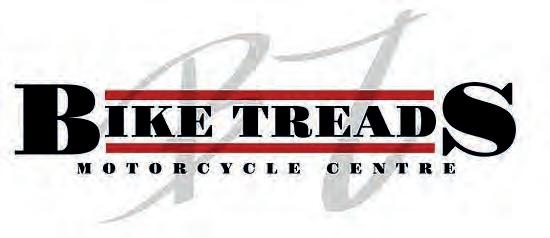





























































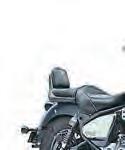






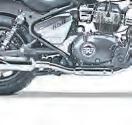












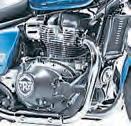




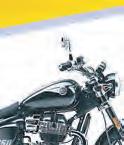



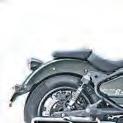





















FIRST RIDE: SUZUKI V-STROM 1050 DE
STROM RIDERS ON THE
There’s a lot to like about the new Suzuki V-Strom 1050 DE. But is a bigger front wheel and some new electronics enough to help entice adventure bike fans to make the switch? Report by Ross Mowbray

TECH SPEC
Suzuki V-Strom 1050 DE
Engine: 1037cc liquid-cooled, 90-degree V-twin
Frame: Twin-spar aluminium
Suspension: (F) KYB 43mm forks, fully adjustable (R) KYB shock, pre-load adjustable
Brakes: (F) 2 x 310mm discs with four-piston radial Tokiko callipers (R) 260mm disc with twin-piston Tokiko calliper
Tyres: (F) 90/90 x 21 (110/80 x 19 on the standard version) (R) 150/70 x 17
Fuel tank: 20 litres
Seat height: 880mm
Weight: 252kg
Price: £13,855 (£13,155 for the standard version)
Contact: www.bikes.suzuki.co.uk
18
Suzuki’s big adventure bike has been doing its own thing for quite a few years now. First launched over 20 years ago, back in 2002, the V-Strom’s carved out a niche in an ever-crowded market, offering potential adventurers a slightly more ‘sensible’ alternative to the bigger, badder and more off-road capable competition from the likes of BMW, KTM, Ducati and Honda. Its bread and butter has always been munching the miles, laden up with luggage and a pillion – and rider’s over a certain ilk love them for it. And why wouldn’t they? After all, not everyone needs a 21-inch front wheel, sophisticated electronic suspension and the latest technology. Or maybe they do. Because Suzuki’s just released a new version of its flagship adventure bike that gets closer than ever to competing with the biggest names in the game. It’s called the the V-Strom 1050 DE (or Dual Explorer).
Don’t worry. There’s still a standard V-Strom 1050 to choose from, which has been nipped and tucked and tweaked and improved for 2023 – although It might not look like it at first glance, because the two bikes are running the same engine, frame andstyling as the previous model. Thankfully the swanky clocks, a tip-top electronics package and a few clever changes hint that the newest ‘Strom’ could be the best yet. And the DE takes things even further with a 21-inch front wheel, longer travel suspension, more ground clearance, and a few additional off-road related goodies to help make it better suited to take on the rough stuff (including a taller seat, wider bars, a shorter screen, a chunkier chain and a proper bashplate). But what’s it actually like to ride? We went out to ride it on the launch ride in Greece a few weeks ago to find out.
The DE feels like a completely new machine to the standard V-Strom – despite the two bikes sharing a whole lot. It somehow feels slimmer, thanks to a slightly narrower seat, and strangely light, despite it weighing 10kg more than the 242kg standard machine.

As you’d expect, the 1037cc, 106bhp motor goes extremely well. The 100Nm of torque is available nice and low down, with plenty of grunt available to dispatch traffic on the road and get the back wheel spinning off it, while the up and down quickshifter makes it impossibly easy to flick between the gears. It really is a fantastic set up, and it’s great to have something slightly different to the deluge of parallel twin powered bikes currently flooding the market. Although there is a bit of vagueness from the larger 21-inch front wheel, the drier roads and Dunlop Trailmax Mixtour tyres combined to provide plenty of confidence while cornering.
The Tokico brakes do a good job of hauling it up in
a hurry, although the longer travel KYB front forks do have a tendency to dive under extreme pressure. Not enough to unsettle the bike, but enough to notice. Overall though, the suspension is good. There’s none of the electronic trickery we’re starting to see from other manufacturers, but the Suzuki doesn’t need it. There’s full adjustability, so you can dial it in just how you like it.
It might not have trick electronic suspension, but Suzuki has packed a whole load of technology into the new bike. There’s a new six axis IMU; a ride-bywire throttle; cruise control; hill hold control; slopedependant control (anti-stoppie, basically); adjustable traction control and ABS (which has two settings and can also be turned off); and Suzuki’s Drive Mode Selector, which even includes a dedicated Gravel mode. It’s an impressive package, that’s a real step forward for the V-Strom. Oh, and let’s not forget the new 5-inch TFT dash. It’s also worth mentioning that you don’t have to mess around selecting modes and fine-tuning settings each time you set off, because the Suzuki actually remembers them. Sounds obvious, but a surprising amount of bikes revert back to road mode as soon as you hit the kill switch. The riding position’s good, too (no matter whether you’re sitting and standing), thanks to the wider bars and slightly taller 880mm seat, and I’d have no qualms about comfort if I was planning to do some big days on- or off-road.
Overall, Suzuki has done a cracking job with the DE. It’s a whole load better than I expected it to be. Okay, so it might not be the most stylish, most sophisticated or most capable choice in the busy adventure bike market, but it’s priced at a pretty competitive £13,699 and has everything you’d need for a proper good explore.
If I’m being totally honest, it’s still not a ‘proper’ off-road capable adventure bike. It’ll muddle through and do the job, but I suspect it’d quite quickly come unstuck on some seriously tricky terrain. It kind of feels like Suzuki’s stuck a bigger front wheel in the road bike, and I suppose that’s because that’s basically what the factory’s done. But that still doesn’t stop it being a bloody good motorcycle. It’s just that if you’re after some serious off-road chops there’re quite a few other bikes that’d do the job much better. That said, you’d also likely end up paying a whole load more cash for the privilege. But despite the criticism, there’s no doubt that the DE is a solid effort at building a more dedicated off-road capable adventure bike – and credit must go to Suzuki for having a go.

If you want to hear exactly how I got on with the two new V-Strom 1050s, then be sure to check out the upcoming issue of Motorcycle Sport and Leisure for the full, in-depth review.
Here’s the ‘standard’ V-Strom 1050 in all its glory. It had a hard go of it out on the launch, with the morning ride a literal whitewash (due to snow). It’s a cracking bike though, retaining the previous generation ‘Strom’s brilliant V-twin engine in addition to a whole host of upgrades for 2023, including some electronic goodies.
FIRST RIDE: SUZUKI V-STROM 1050 DE 19







































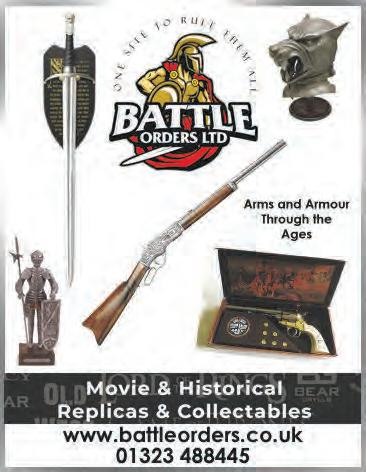

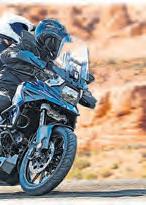
















































































































































If this teaser tickles your fancy and you want to know even more about the latest Ducati Diavel V4, scan the code and snag yourself a copy of Fast Bikes. Those lads really know their onions when it comes to bikes built for speed.

Big, heavy, and unapologetically quirky, the Diavel has divided opinions since it bounded into our lives 13 years ago. But there’s a box-fresh offering for 2023 and maybe, just maybe, Ducati has mastered a sportier formula that’ll appeal to the masses. WITH THE

DANCING
DEVIL

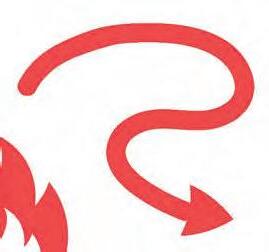
FIRST RIDE: DUCATI DIAVEL V4 21
There are those born desperate to fit in and there are others who would sooner chew their own arm off than join the ranks of convention. The same goes for bikes, with the king of the renegades being Ducati’s Diavel.
It’s been unashamedly different since the very get-go, audaciously bursting on to the scene in 2010 –and the model’s now on to its third iteration and has cranked up 45,000 unit sales to its name… which is another way of saying it’s been a bloody big hit for the Bologna brand. The question is, what happens next for this extrovert power cruiser now it has ditched its V-twin motor for a smaller, but pokier V4 option? In fact, it’s dropped a number of things, including a whopping 13kg in mass, of which 5kg came from the engine alone. Based largely around
Bruce Wilson PHOTOS: Ducati the Multistrada V4’s motor, there’ve been some tweaks to the cams (to help lower emissions); the airbox (now integrated into the bike’s ‘front frame’); and the exhaust system (which is nothing short of a whopper). The culmination of this sees an output of 165bhp, with 126Nm to make sure no Nova ever beats you away from the traffic lights again…
As familiar as the Gran Turismospec motor may be, the one thing that makes it truly unique is the integration of rear cylinder deactivation. In anything over first gear, if you’re under 4000rpm and tootling along, the rear cylinders will knock off completely, only coming back to the party once you cross the aforementioned threshold or if you give the throttle a meaningful twist. Why would you want that tech, you might wonder? Ducati’s reasoning, given during the model’s presentation in Dubai, was twofold, with the first gain being to rider comfort, as the bike runs so much cooler without the rear cylinders firing. The second is that it made a huge difference to the V4’s emissions and efficiency, the buzz words of these times. It might be meaner, but it’s also cleaner than the Diavels before it.
Other tweaks include a sharper rake and trail to get the bike turning. Don’t forget – this is a machine with a whopping 240-profile rear tyre and that weighs in wet at 223kg (without fuel), so any gains in the cornering department are heavensent. For a bike that heavy, braking is pretty important, too, which is why the Ducati’s now been kitted with top-spec Brembo Stylema callipers and advanced Bosch ABS assistance that can be altered with ease on the TFT dash for optimum road or track characteristics.
As per all modern Ducatis, there’s very little the Diavel’s lacking in the tech department, with keyless ignition being your point of access to its impressive suite. Simply hit a button between the tank and five-inch TFT colour dash and the latter will light up like Blackpool illuminations. The switchgears are backlit, too, a nice touch, and they’re also familiar in shape for those who have ridden any modern-era Ducati. That’s a good thing, because they’re super-easy to operate and the features on the dash are clearly visible and intuitive to alter. It’s got everything – from traction control to four different rider modes, plus options to dial down the power on tap or tweak away at the shifter or blipper.


I’ve tested bikes the world over, on race tracks, in dockyards, through rivers and even around car parks… but never up a closed, floodlit mountain pass, 1000 metres above the Dubai desert. This launch was as unconventional as the bike we were testing, and I considered that a good thing. I thumbed the V4 into life, and it emitted a reasonable rumble from the underslung exhausts. Maybe a bit more noise would have been appreciated, but it perked up with revs, me having slotted the bike into gear and trundled off towards the start of our test route. At the slow speeds we were riding while getting acquainted with the road, it was impossible to ignore how agile and easy the bike felt to manoeuvre – but how would it cut it when the hammer was down and the footpegs were sparking?
The bike is kitted with four riding modes (wet, urban, touring and sport) that alter its characteristics and feistiness. We’d been asked to keep it in touring during the night rides, but now was our chance to access
TECH SPEC
Ducati Diavel V4
Engine: 1158cc, V4
Claimed power: 165bhp @ 10,750rpm
Claimed torque: 126Nm @ 7500rpm
Frame: Aluminium monocoque type

Suspension: (F) 50mm fully adjustable USD forks (R) Fully adjustable monoshock
Brakes: (F) Brembo Stylema callipers, 330mm discs (R) Twin-piston Brembo calliper, 265mm disc
Seat height: 790mm
Wet weight: 236kg
Fuel capacity: 20 litres
Price: £23,595 (Ducati Red) / £23,895 (Thrilling Black)

Contact: www.ducati.com
full power in sport mode, opting for the sharpest of the power delivery options, too. As an added touch, more out of curiosity than anything, I also put my bike in track ABS. I hadn’t got the ABS kicking in during the night rides, but I liked the idea of disengaging the rear ABS, which is what the track/performance settings allowed for.
We left our base and got to the top of our run, following our leader once again down to the bottom at a relaxed pace while getting plenty of heat into the Pirelli Diablo Rosso III tyres it’s kitted with. When the time came to blast back up the hill, the pace was awesome and the smile on my face was broader than a Cheshire cat’s. The power of the Diavel felt significant and so easy to access, pulling strong in second and third gear, which seemed to be the common denominators throughout our antics. For those wondering whether this bike has lost its character along with its V-twin
motor, don’t sweat it – it had loads on tap, along with relentless amounts of torque… 126Nm is significant in any configuration.
As impressive as the engine was, the thing that hit me most was how well the bike handled. It defied its own looks, physics, and all the preconceptions I’d had. Okay, the pegs decking out became way too common, but the general flickability of this thing was beyond impressive for such a big beast – and it felt superplanted.
The truth is, as I learned throughout the rest of the day’s anarchy, the Diavel can be whatever you want it to. At slow speeds it was a choirboy, with a tidy turning circle, a relaxing riding position and a motor with real table manners. But when it came to turning up the wick, it morphed into the consummate headbanger in a heartbeat. It was wild, but in a good way, and that made it endearing on so many levels.
WORDS:
22 FIRST RIDE: DUCATI DIAVEL V4
COAST-TO-COAST

Back in December, we rode Suzuki’s GSX-S1000GT from coast-to-coast, through the Lakes, the Dales and the North York Moors. Here’s how we got on.

POWERED BY
ROUTE FINDER 23
Words: Ross Mowbray Photos: Gary Chapman
If you’re into riding bikes, December can feel a bit grim. The days are shorter, the nights seem darker, and more often than not there’s rain falling from the sky. All that’s not exactly conducive to a good day’s riding, is it? But maybe it doesn’t have to matter. We spend plenty of time on the bike over the winter period, and although it’s not got quite the same appeal as a sunny summer day spent exploring on bone-dry roads, there is something special about getting out there when everyone else is nestled on the sofa dreaming of better weather.
It can be hard work, and it can be a bit of a slog if it’s hammering it down, but when you’re treated to 20 minutes of sunshine, or a dry stretch of road, or a glorious view, it all seems worth it. And that’s part of the reason we’ve been out on the road, doing some cracking winter rides that we hope will inspire you to get out on the bike during this time of year. We want to show you that with a bit of preparation, some decent kit and a bit of hardiness, there’re tons of cool places to ride right across the UK, even in the darkest depths of winter.
That’s why we’ve put together this rewarding ride, which offers some of the finest motorcycling this country has to offer, courtesy of three National Parks. Starting in St. Bees over on the west coast of Cumbria and finishing in Whitby on the east coast, by way of the Lake District National Park, the Yorkshire Dales National Park, and the North York Moors National Park, this ride is a special one. And we had just the tool for the job: Suzuki’s GSXS1000GT.

The ride
Although the start of our route is in St. Bees in Cumbria, the Suzuki and I had to actually get there
first. Leaving later than planned, with the light already fading and the rain falling gently, I wasn’t exactly thrilled to get stuck into the slog from the Lincolnshire Wolds. But needs must and I hit the road with the sat-nav set for Wetherby where I’d have a brew and thaw out.
Those first few miles were good; steady to start with while I got used to the grip available from the Dunlop rubber, the power available from the engine, and the stability of the suspension with the panniers full to the brim. I wasn’t blown away, but I was pleasantly surprised with how comfortable I felt even as the rain became heavier and heavier. And as I racked up more miles, the Suzuki and I had found our groove and were dispensing of slower moving traffic quickly and efficiently. I didn’t have bags of time available, so I just blasted up the motorway to Scotch Corner and then jumped on the A66 to nip across the country to the west coast. It wasn’t the most thrilling ride, but it gave me a good taster of the GT and had me ready and raring for the coastto-coast the next day.
But hitting the road the following morning with ice still on the ground wasn’t exactly the start I was hoping for. A few miles in and things were looking up. The roads were starting to thaw, the sun was popping through the clouds and, best of all, I was riding a bike in the Lake District. That said, I must credit the GT as being incredibly easy to tip-toe around on some seriously slippery surfaces. Its smooth throttle, intuitive brakes and top tyres made it manageable for even a ham-fisted fool like me to keep things the right side up on a morning when it’d have probably been wiser to stay tucked up in bed. With the grip returning, it didn’t take long to realise that the GT is a very good bike indeed. I already knew that the rev-happy engine (which has
enough poke to break every speed limit in the UK in first gear) is an absolute hoot. It’s versatile, too, and you could quite easily shift up to sixth as soon as you get on a national speed limit road and still have enough response from the engine to do overtakes without shifting down. That said, Suzuki has put such a good quickshifter on the bike that changing gear is a joy.
With a lot of miles left still to do, I was glad that the riding position was more relaxed than sporty, with the handlebars sitting fairly high and wide. And while the pegs are in the same position as the GSX-S and the seat height is the same 810mm, it’s noticeably more comfortable. After a full day’s ride I felt like I could have quite happily carried on, with no aches or pains at all, despite the freezing weather.
It should come as no surprise that the GT is in its element on fast A-roads. It’s fast, smooth and stable with plenty of poise under pressure. But it most surprised me when bombing along chewedup B-roads. The suspension did an admirable job of keeping the ride controlled. It’s not exactly the fastest handling of rides, and you’ll have to muscle the 226kg machine around if you really want to hustle. And in any case, the lack of directness is more than made up for in other ways.
The GT lapped up two days of touring, on almost every type of road in almost every type of weather. It banged out the motorway miles, blasted along fast twisties and even nipped along chewed-up back roads. It proved itself a comfortable, easy-to-ride and enjoyable bike that can make rapid progress seem effortless – and it really feels like a proper dedicated tourer, rather than a naked bike with some bodywork bolted on. It might not be the most sophisticated, but it doesn’t need to be, particularly at a cost of £12,499. Top marks Suzuki.
TECH SPEC
Suzuki GSX-S1000GT
Price: £12,499
Engine: 999cc, inline four
Power: 150bhp @ 11,000rpm
Torque: 106Nm @ 9250rpm
Transmission: 6-speed, chain final drive
Frame: Twin-spar aluminium frame, aluminium swingarm
Suspension: (F) 43mm KYB inverted front forks, fully adjustable (R) Link type, rebound damping and spring preload adjustable
Brakes: (F) 2 x 4-piston Brembo monobloc callipers, 310mm floating discs, (R) Single disc and calliper
Wheels/tyres: Six-spoke cast-aluminium wheels / Dunlop Sportmax Roadsport 2, (F) 120/70ZR17M/C (58W), (R) 190/50ZR17M/C (73W)
Seat height: 810mm (31.9in)
Tank: 19 litres (4.2 gallons)
Consumption: Claimed 46.3mpg (16.4km/l), tested 42mpg (14.9km/l)
Kerb weight: 226kg
Service intervals: 7500 miles
Warranty: 3 years
Roadside assistance: 1 year UK cover
Contact: bikes.suzuki.co.uk
24 ROUTE FINDER
THE ROUTE
The Lakes
Kicking off the trip in St. Bees, it’s a small hop, skip and a jump into the Lake District proper, where the riding starts to get good. If you steer clear of the big main roads, you really can’t go wrong and you’ll be treated to some of the best riding in the country (and at this time of the year, there’s barely any traffic on the road). Our route carried us past Ennerdale Bridge, along the shores of Loweswater, Crummock Water and Buttermere, before heading up and over Honister Pass (it’s well worth a stop at the café up top to soak up the views and grab a coffee and butty). From there, follow the road past Derwentwater all the way to Keswick where you should cut back down and head for Lake Windermere, before hooking a left and meandering past Ullswater on the way to Penrith before turning off and pointing for Shap, where you’ll nip across the M6 and cross the border into Yorkshire.


The Dales
From there, there’s a quick blast on the A685 to Kirkby Stephen, before turning off and heading along the B6270 to Keld, then Thwaite, and then Reeth, nearly all the way to Richmond. It’s a stunning stretch of road (because of both the riding and the panoramic views), which starts by snaking up and over the moors before gently descending into the dales. It’s slow going at times, and you’ll pass through lots of villages on the way, but just be patient and enjoy the ride. It’s actually a stretch of road I’ve never done before, having always got what I needed from the equally satisfying A684 which runs all the way from Sedbergh to Bedale, but I’ll definitely be back for another blast in the not-too-distant future.
The Moors
From Richmond, we head for Danby Wiske and then on to Ingleby Cross along a selection of decent, but less than stunning, B-roads, before reaching the third National Park of the day. From there it’s a quick blast up the A172 to Carlton-in-Cleveland where we nip off the main road along some tight, twisty and challenging little roads before arriving in Chop Gate, which sits on the iconic B1257 which leads to Helmsley in the south. If you’ve time, this is a really excellent bit of Tarmac that we’ve ridden lots of times. It’s best ridden in one hit from Stokesley in the north all the way down to Helmsley (or vice-versa) – but even if you’re only doing a little bit of it, there’s no doubt it’ll put a smile on your face.
That’s not the way we’re going though, and we head on to Clay Bank before turning off and heading for Ingleby Greenhow and Easby before hooking a right and pointing for the moors. From there it’s on to Kildale, Castleton and Danby, all the way to Glaisdale. It’s another cracking stretch of road, narrow and mostly traffic-free, cutting its way through the bleak, exposed moorland. From Glaisdale it’s a quick nip up to the A171 and before you know it you’ll be arriving in Whitby, ready to stock up on fish and chips.
ROUTE FINDER 25
URBAN RIDING
WORDS: Mikko Nieminen / PHOTOS: Gary Chapman
Bad news first: Urban riding is not as easy and safe as you may have thought. But don’t despair, we had a chat with Ryan Decarteret, National Operations Manager and Coach at Rapid rider training, to get the lowdown on what to look out for in the city...
MB: Why does urban riding need special consideration?
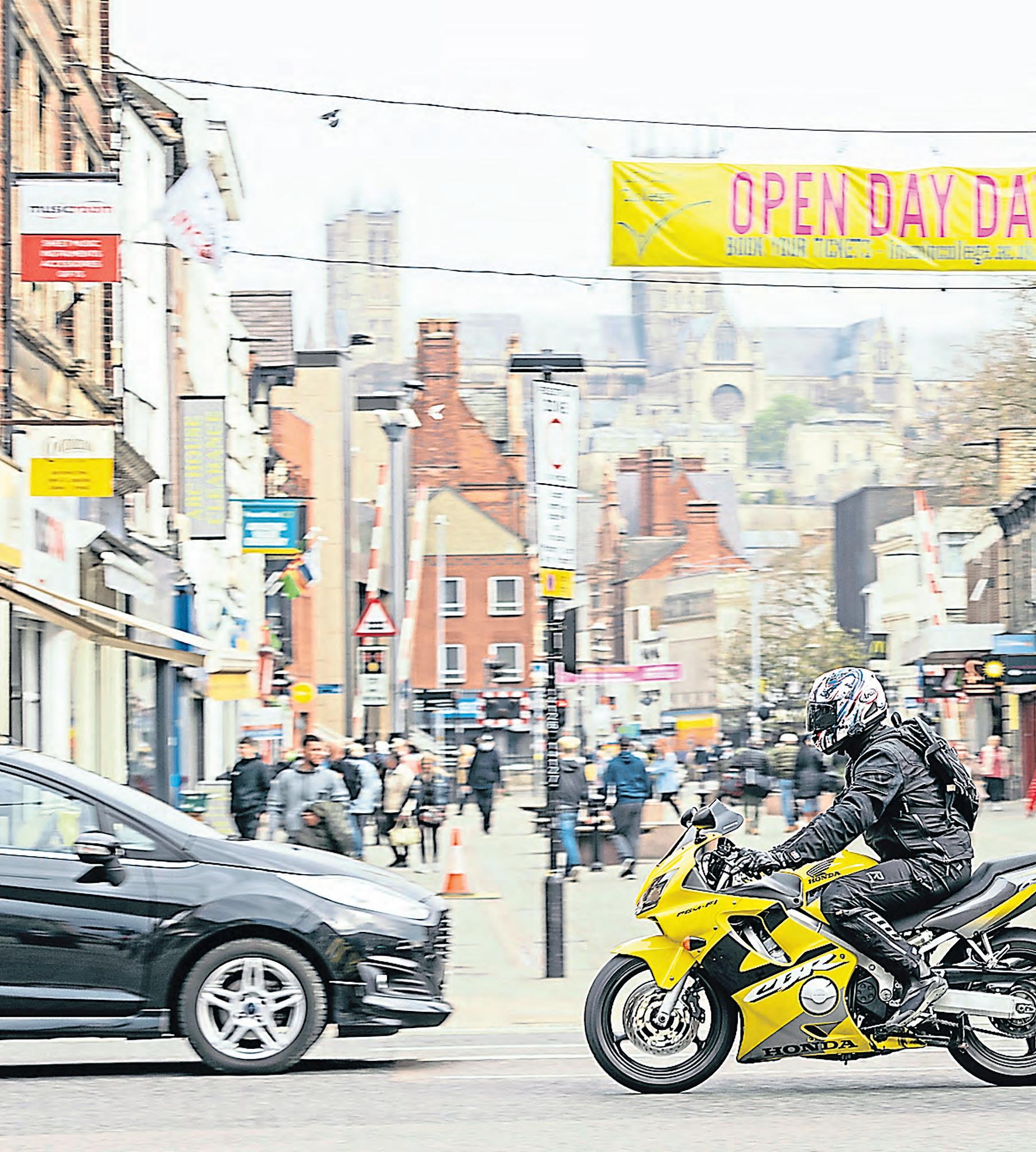
Ryan: Urban areas present a huge number of hazards in a small area, which is, of course, why the speed limit is reduced, and this creates a false sense of security. After thumping through the A and B roads of the countryside it’s very easy to feel safe and in control at 30mph and below, but the reality is that so much can happen.
Generally speaking, you’re unlikely to experience anything near as catastrophic as having an issue at the national limit, but there is a higher likelihood of something happening.
Also, a cracking national road into an urban limit will have a high likelihood of static or mobile speed traps.
MB: What are the key considerations in urban riding?
Ryan: It starts with a change of mindset when entering urban areas from highways, and the need to adjust what hazards we’re looking for, and where we look for them.
Reading the road and planning your ride happen in the same way as on faster roads, but there’s so much more detail to be picked up in the near distance: pedestrians and their age (children being a less predictable hazard); dogs (are they on a lead and under control?); side streets; delivery vans and workers. Is it pub closing time or rush hour with everyone fighting to get to work/home on time? Lights are constantly changing, and the road surface has more going on than a multi-topping pizza, especially in the wet.
MB: So, what do you do?
Ryan: Urban riding is more planning
than action. If a rider positions for every conceivable hazard, then the bike will be all over the road, looking to the untrained like they are just swerving for the sake of it, or to show off. Instead, the rider needs to note all the dangers and prioritise them. A van reversing from a parking space will be a higher priority than the junction you can see into, for example.
Tiny adjustments in speed are required for a quality ride in an urban area and contrary to popular belief (or certainly some clients I’m coming across lately) this is not the time for cruise control.
MB: And how does that work in practice?
Ryan: All things considered, position between the centre lane markings and the centre of your lane. This allows the rider to see over and around the vehicle ahead, whilst being in a position to be seen by other road users. Don’t close the gap on the vehicle ahead, especially a high-sider, like a van. Just like on the open road, leave yourself some time!
Remember that a speed limit is just that, a limit, not a target. It’s a classic line, but one that rings true in a busy area. Your speed will often be dictated by the traffic ahead, but keep it appropriate to the hazards and conditions you are up against.
Select a flexible gear with enough go to get you out of trouble, but enough slow (engine braking) to be usable.
We’re fortunate in the UK that filtering is legal in most circumstances and is often expected by the queuing vehicles. However, there is a very fine line between filtering and dangerous riding. If you’re trying to force yourself through a gap that’s closing/isn’t really there, then you’re on your way to being closer to the dangerous side of things. Just because something is legal, that doesn’t make it wise. Be smooth, stay calm, plan ahead and work the traffic when there’s an advantage, and show some patience and restraint when it’s not possible to push on.
Pottering through towns and cities is often considered easier and safer than riding on faster roads, but that’s not necessarily the case…
26 KNOWLEDGE
Rapid Training
Founded in 1997 by a group of ex-racers and current police riders, Rapid set out to deliver a fresh approach to rider development with its own, relaxed, no-nonsense approach to coaching. No formality, no student bibs, just passionate riders being coached by the most highly qualified professionals in the business – and having fun. The company claims to offer the most comprehensive and advanced rider coaching available in the UK. www.rapidtraining.co.uk

The Expert: Ryan Decarteret
Ryan is a passionate motorcyclist, Rapid National Operations Manager and Coach with a background in surveillance and covert police riding, with around one million miles of riding experience (and he says he’s still learning).


KNOWLEDGE 27











The greatest of them all

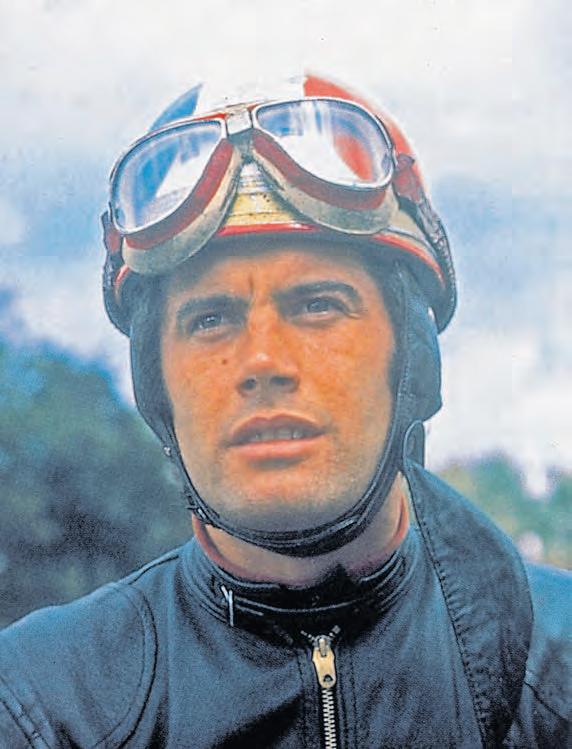















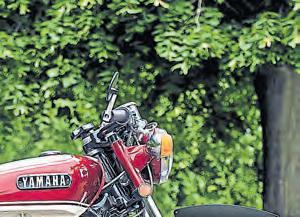




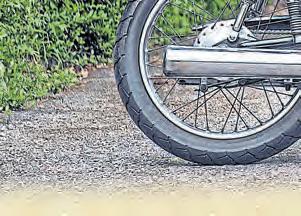












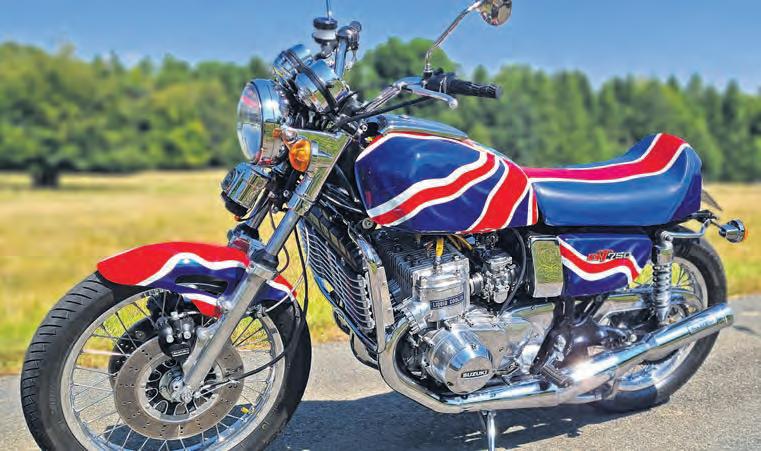








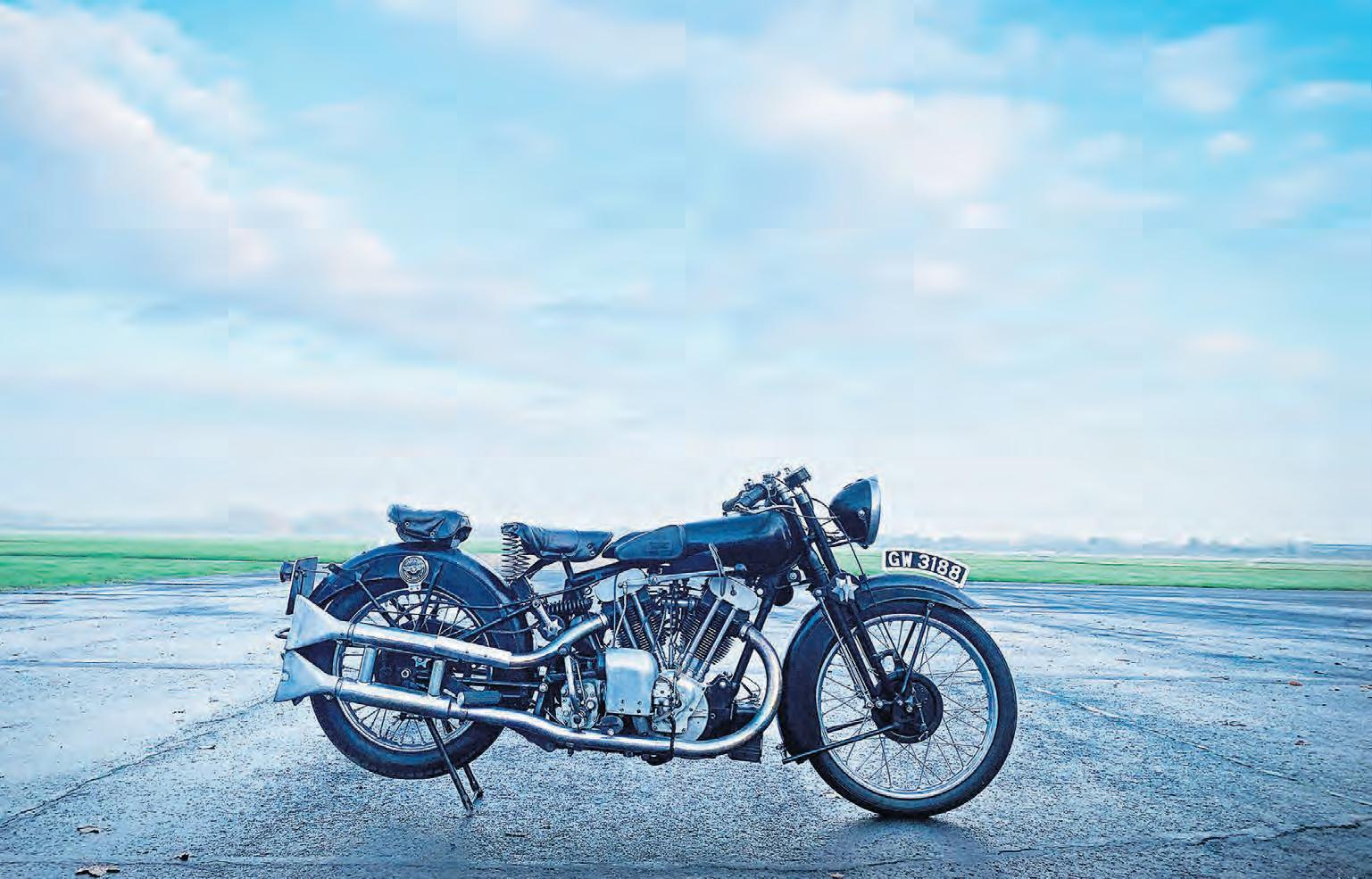


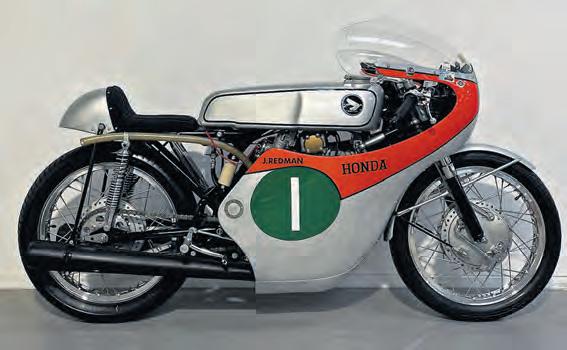


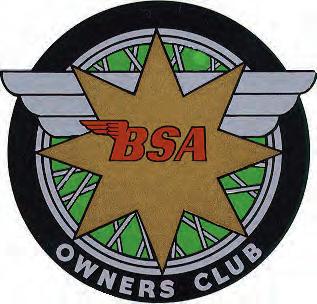



























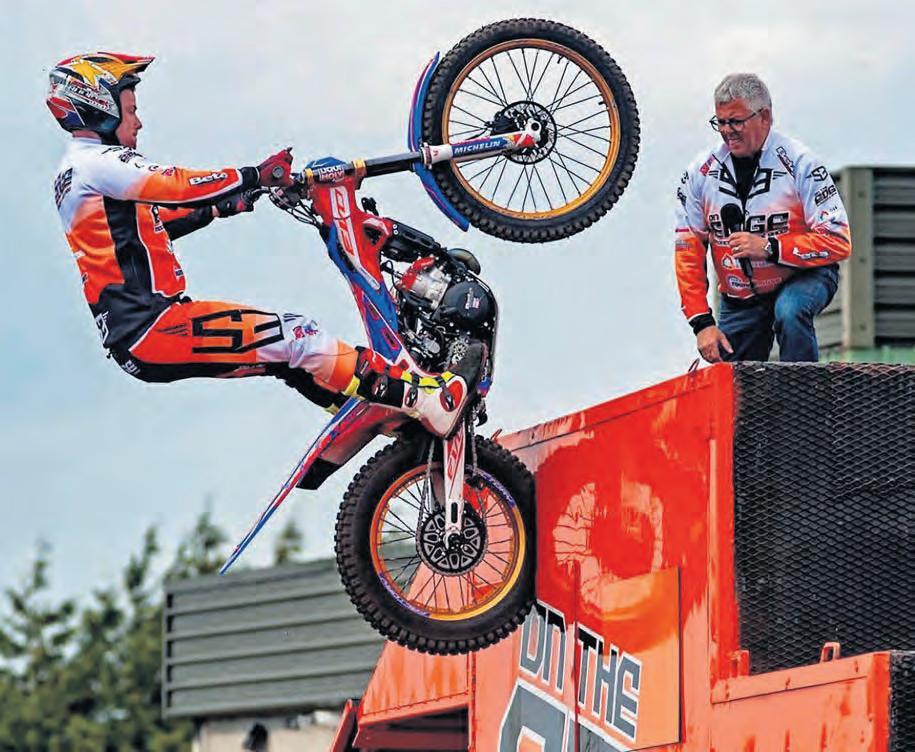
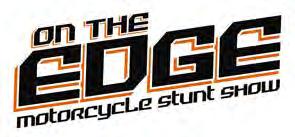









































































































































































































































































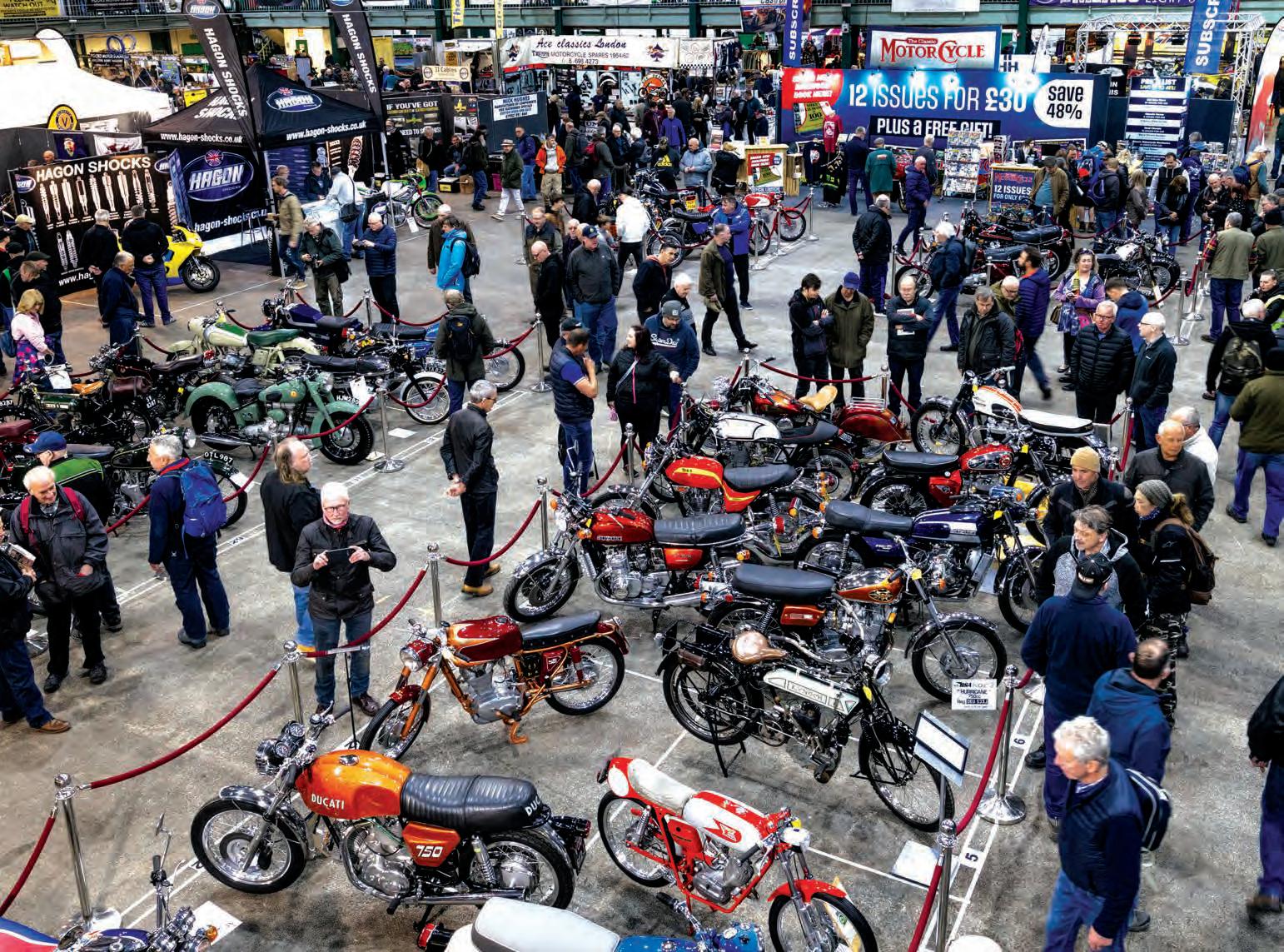








CAMPING AREA CARAVANS AND MOTORHOMES OUTSIDE TRADE OUTSIDE TRADE LIVE MUSIC SEATING AREA BAR TRIALS DISPLAY AUCTION HALLS MAIN HALL SIDE HALL 1 & 2 BALCONY VISITOR ENTRANCE ENTRANCETRADE CARPARK OUTSIDE TRADE PRESTWOOD COMPETITION HALL VISITOR ENTRANCE www.staffordclassicbikeshows.com
We love to see what you lot are riding – and we know the rest of you like it, too. It’s just like pottering around a bike night and checking out what’s been brought out for a ride. Now we’ve decided to bring the bike night to you, asking readers to send us photos of their pride and joy for the world to see. Here’re some of our top picks from the last month.
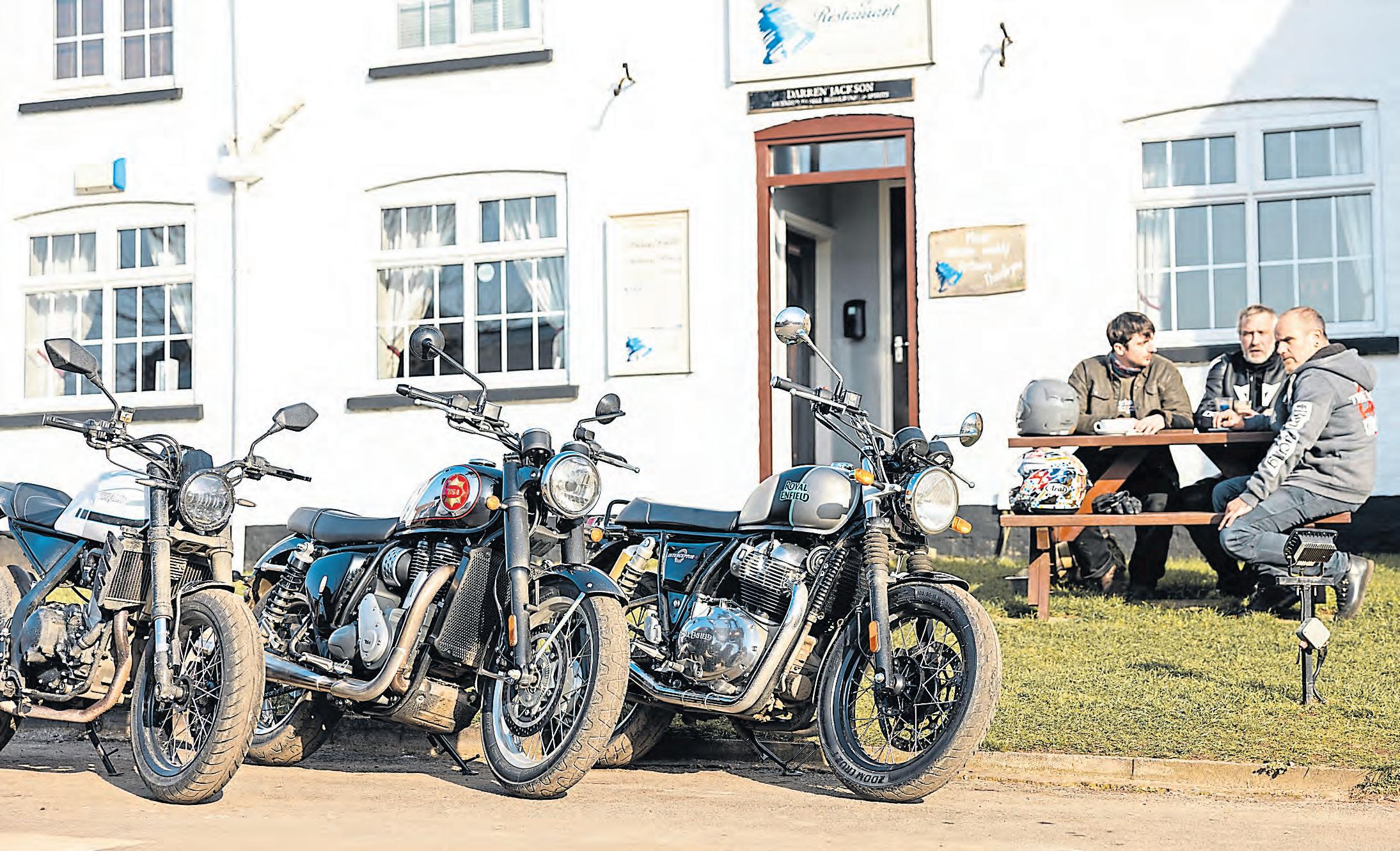









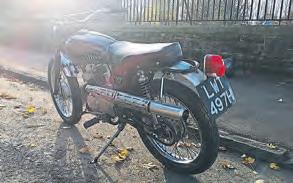
WE NEED YOU!

We’re on the hunt for the best biker destinations the UK has to offer – and who better to ask than you lovely lot! Send us snaps of your favourite cafés, pubs, dealers and workshops, tell us why you love them, and we’ll shout about them on these very pages.
■ Send your snaps to rmowbray@mortons.co.uk
 Alen Aldred’s lovely little Bridgestone TMX 100.
Paulo Baltazar’s much-loved Honda VFR. It’s a proper workhorse if we’ve ever seen one.
Don Jones has owned his super-reliable BMW R90S since 1979. He still rides it more than any of his other bikes.
Tony Schnauzer’s 1985 Honda Gold Wing looks like its ready for cruising the States.
Andrew Langdon’s not road legal but still awesome Honda VFR!
Rick O’s Triumph Thruxton R from 2019 bringing us a bit of modernretro goodness.
Grey Bear’s Aprilia Tuono Factory from 2008. We bet it sounds mean with that Akrapovic can.
Barry Tucker bought this Laverda Jota new way back in 1979 when he was just 20. Now they’re both 44 years older, but still have plenty of fun together.
Simon White’s Aprilia Dorsoduro 900. Lovely bit of kit that would put a smile on the face on any biker.
Alen Aldred’s lovely little Bridgestone TMX 100.
Paulo Baltazar’s much-loved Honda VFR. It’s a proper workhorse if we’ve ever seen one.
Don Jones has owned his super-reliable BMW R90S since 1979. He still rides it more than any of his other bikes.
Tony Schnauzer’s 1985 Honda Gold Wing looks like its ready for cruising the States.
Andrew Langdon’s not road legal but still awesome Honda VFR!
Rick O’s Triumph Thruxton R from 2019 bringing us a bit of modernretro goodness.
Grey Bear’s Aprilia Tuono Factory from 2008. We bet it sounds mean with that Akrapovic can.
Barry Tucker bought this Laverda Jota new way back in 1979 when he was just 20. Now they’re both 44 years older, but still have plenty of fun together.
Simon White’s Aprilia Dorsoduro 900. Lovely bit of kit that would put a smile on the face on any biker.
YOUR RIDE 45
Jat Friedman’s Yamaha FJR 1300 from 2008. 93.000 miles and just getting warmed up!
In partnership with Forcefield Body Armour
The Bluebell Inn, Belchford, Lincolnshire Wolds. Purveyors of quality grub, top coffee and the perfect place to pick up a copy of MoreBikes
DEVELOPING THE CONCEPT


Despite the changes made at both prototype and production levels it was now apparent to the Race Team its half-litre four was far from perfect. The OW20 was good but there was still a lot work needed if it was to win the 500 crown. A new bike, designated OW23, had been available midway through the 1974 season and, on paper at least, it offered substantial benefits. A full 21kg lighter than its predecessor, overall mass had been reduced by various means. The crank cases were now magnesium not aluminium, and both crankshafts and gear sets had been slimmed down, allowing the inline four to be 20mm narrower and 30mm shorter – effectively mass centralisation a decade before Honda made it a ‘thing’. At Belgium Agostini found the OW23 to be slower than the outgoing model and following an off in Sweden the former champion ended up in hospital with a broken shoulder. Yamaha’s Tepi Lansivouri did his best but MV’s Phil Read took the championship.
During the closed season many detail changes were made to the OW23. It and the OW19 suffered from a dipsomaniacal thirst so changes to port timing/sizes and carburettor tuning were undertaken. The motors were notoriously peaky even with reed valves fitted, necessitating changes to internal gear ratios for various tracks. Previously changing the cogs had required a complete engine strip but the revised design saw a cassette unit adapted that only required removal of the clutch assembly in order to gain access. The resultant machine, now designated OW26, would carry the factory’s hopes for the 1975 season.
Of the nine races that season Agostini DNF’d three times – twice with engine seizures and once with a puncture. Against this, Read was riding the venerable MV harder than ever in order to make up for its ageing design which harked back some 20 years. If the OW19 had laid down a wording of impending two-stroke superiority, the OW26 sealed the fate of the MVs – just. The 1975 title came down to the final race of the season at the Czech GP where Agostini’s second place behind Read gave him the title by just eight points. Yamaha finally had its premier title!
Despite being World Champions, Yamaha almost parked up and rested on its laurels for the 1976 season whilst it pondered what to do next. Ago’s OW23 was given an OW29 moniker and handed to Venezuelan Johnny Cecotto who had come up through the ranks. A lack of spares part-way through the season and Suzuki’s decision to make the RG500 square four available to privateers saw bike and rider marginalised. Agostini had gone back to MV Agusta, Suzuki’s star was in the ascendant, and people were wondering if all of Yamaha’s efforts had been little more than to prove a point. Was the 1975 title just a one-off or was Yamaha genuinely serious about continuing in premier class road racing?

46 VJMC – FROM THE
ARCHIVE: AGOSTINI
The
enquiries only Tel: 01454 501310 Email: membership_vjmc@yahoo. co.uk Address: PO Box 1949, Yate, Bristol BS37 0BX Office hours: Mon-Thurs,10am-4pm (please leave a message)
Words: Steve Cooper Photo: Mortons Media Archive
VJMC – run by motorcyclists for motorcyclists. For membership
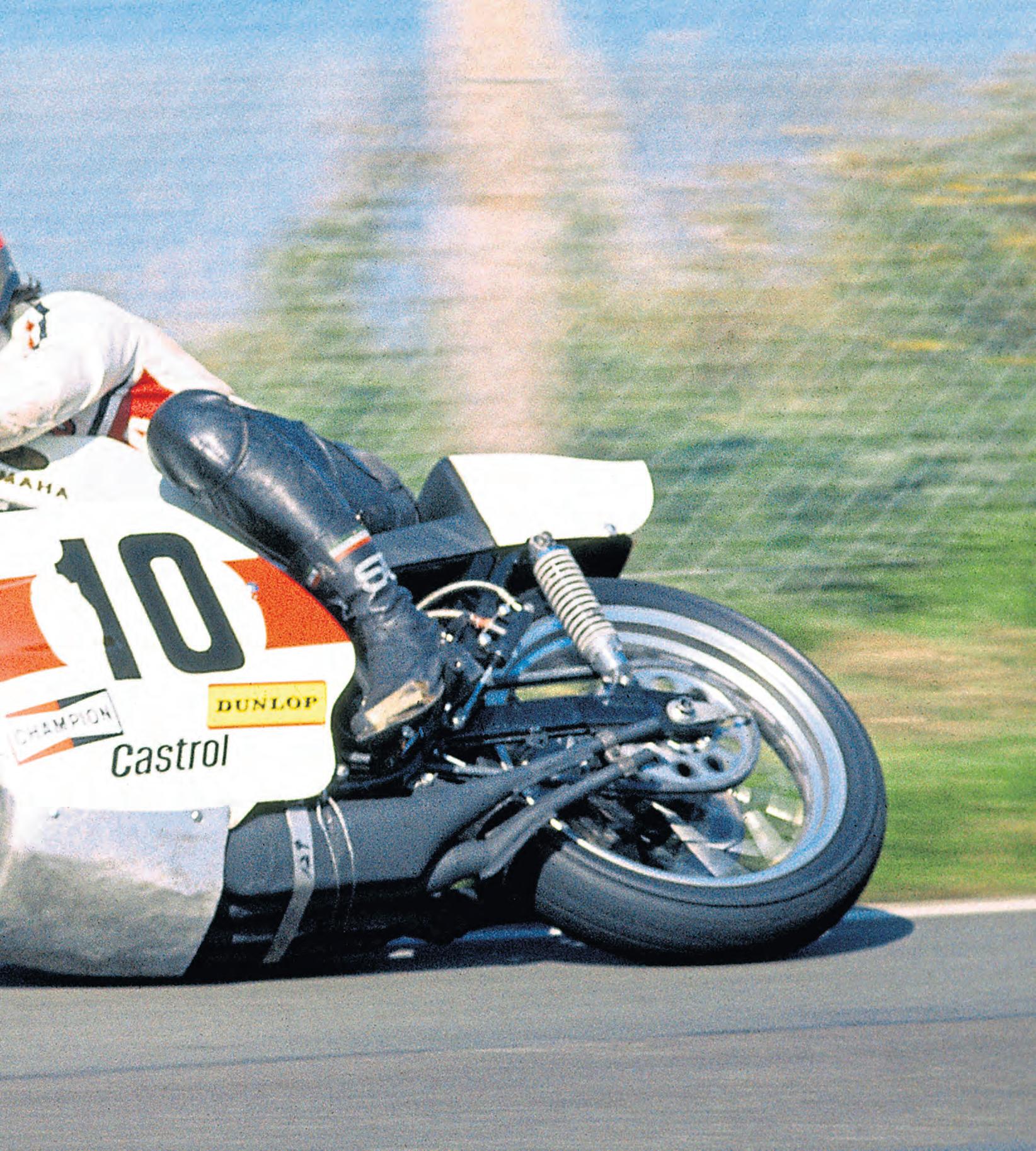




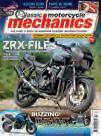

FROM THE ARCHIVE: AGOSTINI – VJMC 47 WANT YOUR FIX OF JAPANESE CLASSICS? THEN YOU NEED... Visit www.classicmagazines.co.uk/cmm296 Call: 01507 529529 and quote: CMM296 6 issues for £24* Expiry: 31/12/23 *UK only offer *Followed by £24 every six months MEET AGOSTINI AT STAFFORD SHOW APRIL 22-23 www.classicbikeshows.com
For many of those who grew up watching motorcycle racing in the 1960s and early 1970s, a four-cylinder, red and silver MV Agusta represented the pinnacle.
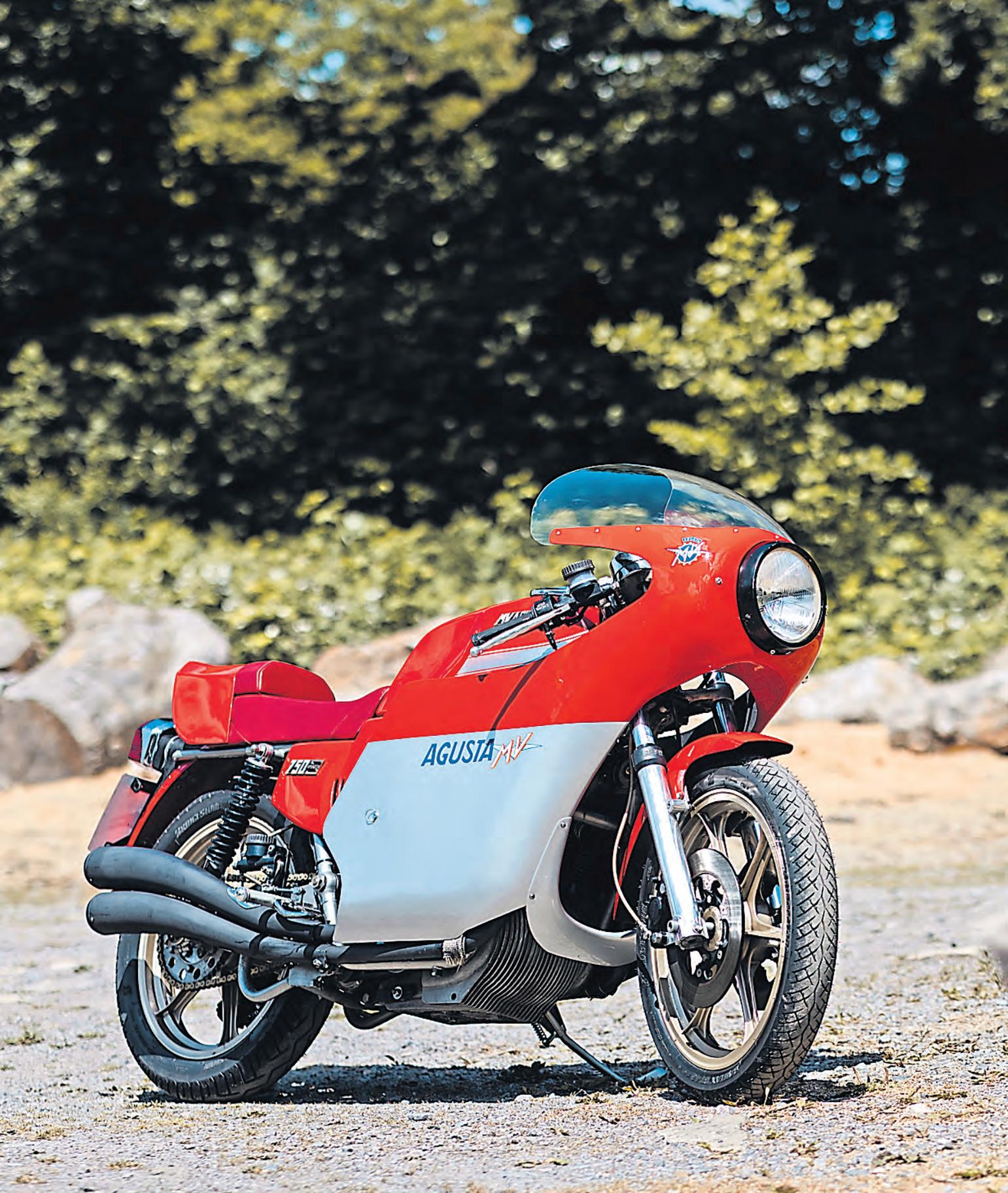
48 ROAD TEST: MV AGUSTA 750S AMERICA
With the twin petrol taps, choke lever and ignition turned on, it took just one press of the starter button to bring this charismatic, four-cylinder Italian masterpiece roaring into action.
For me, the symphony played from the four megaphone silencers brought back many happy memories from a bright sunny morning in 1975, when I was awoken at the Belgian GP by the sound from the pair of works MVs racers – the mounts of Phil Read and Gianfranco Bonera – filling the air. The cacophony of exhaust noise was a reminder for the huge crowd that filled the Spa circuit that July day that, on the fast racetracks, there was still plenty of life left in the Gallarate multi-cylinder four-strokes. It was also the day that I made up my mind that at some time in the future I would get my own four-cylinder roadster with the name of ‘MV’ (Meccanica Verghera) on its petrol tank.
Three years later, on April 14, 1978, I was in a position to hand over my 750cc F2 Honda, an XT500 Yamaha plus a handful of cash to Richard Difazio at Difazio Motorcycles and the dream was complete.
Unlike this month’s test bike –featuring Magni modifications including the raucous exhaust system, cast wheels and chain drive, and which belongs to West Country enthusiast Roger Chapman – mine (AYC 678S) was as it left the factory production line, with shaft drive, slightly muted four-into-two exhaust and wire wheels,
but as I rode away for my first trip across the traffic-free Mendip Hills, it took very little imagination to be the ‘Prince of Speed’ Read, winning that epic race in Belgium three years previously. I ended up owning the MV for 26 years, covering over 60,000 highly enjoyable, unforgettable miles on my Gallarate fire engine.
Before I reacquaint myself with an MV America and get to ride Roger’s superb specimen, let’s backtrack to the early days of MV and reflect on the mere total of 1276 four-cylinder bikes which were produced between 1966 and the factory’s eventual closure in 1978.
The first motorcycle to carry the name of ‘MV’ on its petrol tank was not a screaming, high-speed 500cc four, but a humble 98cc singlecylinder two-stroke. The prototype was produced at the Gallarate factory in 1943 and, war over, went on sale to the general public in the spring of 1946. Meccanica Verghera had been officially formed the previous year but the story of MV really goes back to 1907 when a wealthy Italian named Giovanni Agusta decided to construct his own aircraft, just four years after the Wright brothers had achieved the world’s first powered flight on December 17, 1903, at Kittyhawk in the USA. Not only did Agusta manage to get airborn in his prototype at Capau (just north of Naples) four years later, but also Italy became the first nation in history to use aircraft

in warfare, when it made the world’s first bombing raid during the conquest of Libya.
By 1919 Giovanni Agusta was acknowledged as being one of Italy’s premier aviation experts and the following year he heralded the formation of ‘Constuctioni Aeronautiche Giovanni Agusta’ specialising in the construction, overhaul and repair of both military and civilian aircraft. The company continued to expand, but sadly its founder died, aged 48, on November 27, 1927, and the business passed to his wife Giuseppina Agusta, who soon installed their eldest of four sons Domenico, then just 21, at the helm. The young man soon proved to have a natural flair for commercial life and, not only did he see Agusta through the huge industrial depression in the late 1920s, at the end of the Second World War he would also become the man who would identify that Italy urgently needed two-wheeled transport and the name of ‘MV Agusta’ was born.
During the war, under the leadership of Fascist dictator Benito Mussolini, Agusta had been forced to take on military contracts or go out of business, but with the hostilities at an end, under the terms of the surrender Italian factories were forbidden to produce any aviation products, so the natural progression for the skilled workers at the Gallarate factory was that of a small-capacity motorcycle.
TECH SPEC
MV Augusta 750
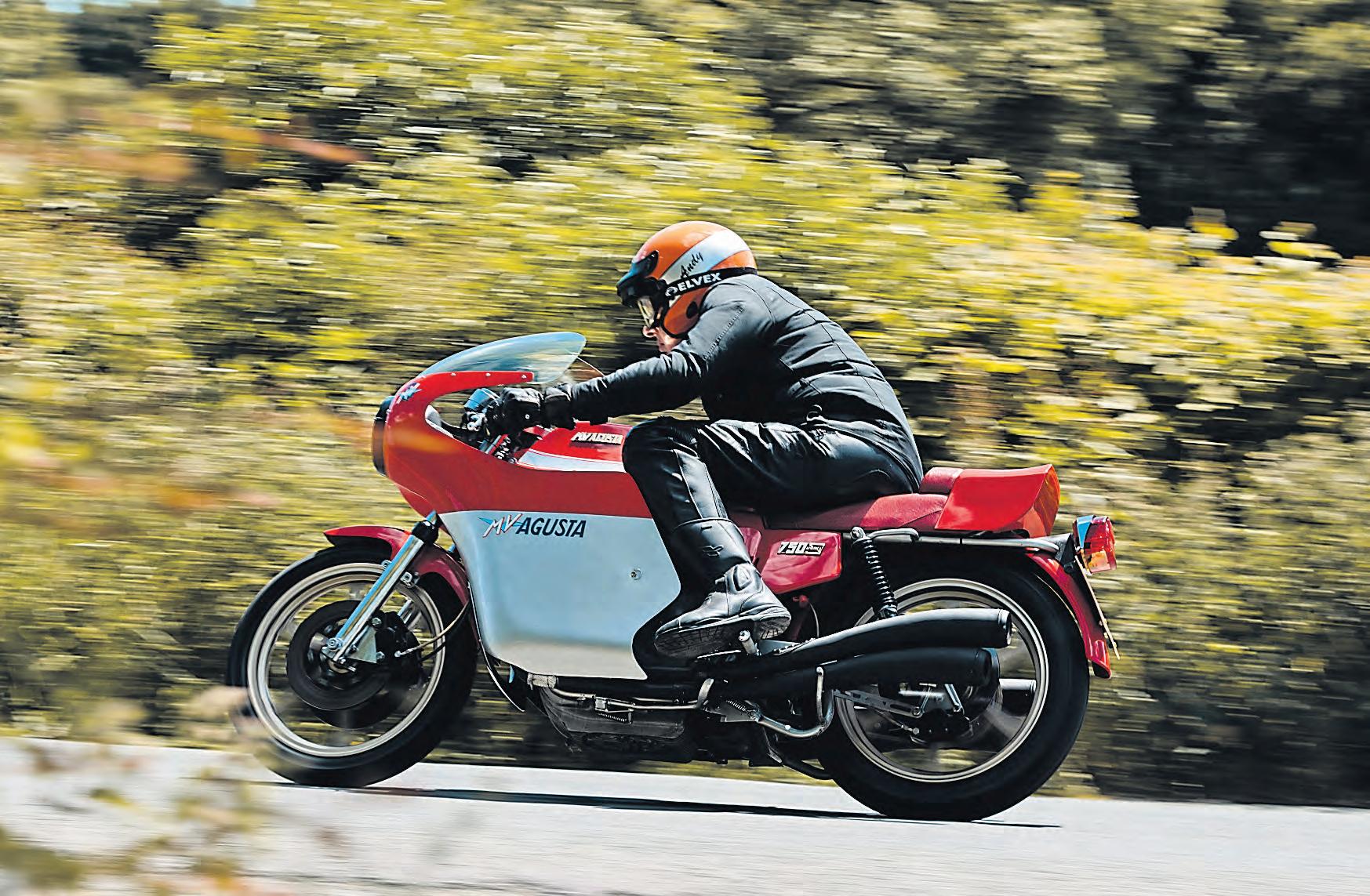
Engine: Air-cooled DOHC four-cylinder fourstroke
Capacity: 789cc
Bore: 67mm
Stroke: 56mm
Power output: 75bhp @ 8500rpm
Carburettors: Four Dell’Orto UB 26 BS2
Ignition: 12-volt
Starting: Electric
Gears: Five-speed foot change
Suspension: Front 35mm Ceriani, Rear Twin Marzocchi
Brakes: Front Twin disc, Rear Single disc (originally drum)
Drive: Chain (originally shaft)
Weight: 518lb (235kg)
Fuel: Five gallons Top speed: 137mph (claimed)
What a view. Just brilliant – and so evocative.
Though a tall first gear means the MV takes a while to get into its stride, it’s soon barrelling along at the national speed limit.
WORDS: ANDY WESTLAKE PHOTOS: GARY CHAPMAN
ROAD TEST: MV AGUSTA 750S AMERICA 49
Domenico would remain head of the family empire until his death in 1971 and, in present times, it is often thought that motorcycle production was the hobby of a rich Italian Count, but this not the case, as from the start of two-wheeled manufacture, it was seen by Agusta as purely a commercial operation. A two-speed, 98cc two-stroke was perhaps not the sort of bike to get the pulse racing, but for the task in hand it was ideal and, by 1950, there were over 250 MV dealers throughout Italy.
Count Agusta was quick to recognise the importance of racing and as early as 1951, Cecil Sandford won the first of MV’s 37 world championships on his 125cc DOHC single. The list of riders who raced MV machinery over the next two decades reads like a ‘Who’s Who’ of motorcycle sport and, in addition to Sandford, includes the greats Les Graham, Bill Lomas, Carlo Ubbiali, John Surtees, Luigi Taveri, Gary Hocking, Mike Hailwood, Giacomo Agostini and Phil Read, the latter the last rider to win a world championship title for the firm, in 1974. As early as 1950 MV had stunned the motorcycling world when it displayed the 500c four-cylinder R19 Turismo at the Milan show, but the public had to wait until 1965 for the first production bike to appear, with the launch of the 600cc four, described at the time as ‘the ugliest Italian bike ever.’ Not surprisingly, it didn’t set the world alight. But the machine which replaced it – the super-sporting 750S – looked like the refugee from the racetrack fans had
clamoured for, when it appeared at the Milan show in 1969.
Although on looks alone the 750S made any enthusiast’s heart pump harder, like the previously mentioned 600cc four it was never destined to sell in any quantity. Its successor was this month’s test subject, the 750S America (actually 789.7cc), a machine which – if period reports are to be believed – went from conception to the finished article in 50 days. Not surprisingly given its name, the bike owes its existence to two Americans, Chris Garville and Jim Cotherman. As the head of Commerce Overseas Corporation in New York, Garville had long been associated with the helicopter side of Agusta, while Cotherham owned a US MV dealership and had built up an enviable reputation as an excellent tuner of MVs.
With their common interest, they started to import limited quantities of both the 750S and its sibling, the 750GT, during 1974, but soon came to the conclusion that with a few changes the Italian fours would make them more saleable to their potentially huge stateside customers. They approached MV, who surprisingly took their proposals on board and, thanks to the driving force of one Fredmano Spairani, it only took 50 days before the first America prototype was completed and fired up.
The two Americans believed it was possible to sell up to 500 bikes a year, and, with this number in mind, MV Agusta geared up for a higher level of production that had ever been attempted for any of the previous four-cylinder models. Sadly,
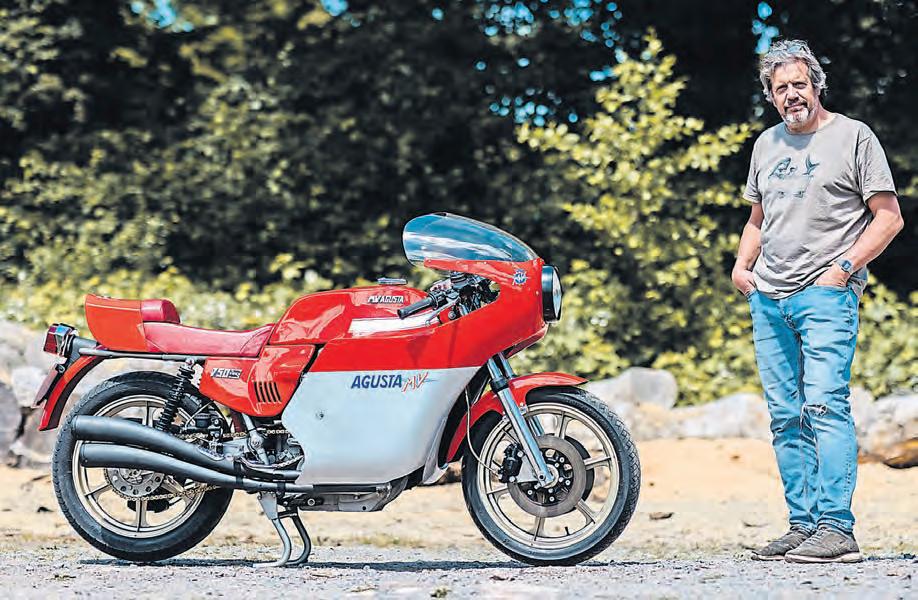




Garville and Cotherman’s estimates on projected sales of the 135mph thoroughbred were hopelessly wide of the mark, and it was reported that machines which were manufactured during 1975 were still being sold off from dealer’s showrooms four years later.
It is reckoned that around 200 Americas came to the UK during the mid-1970s, including this month’s test focus. Owner Roger Chapman is a man whose eclectic collection of classics is well known to regular readers of the magazine. Roger bought the MV from the legendary
photojournalist, ex trials rider and all-rounder Don Morley in 2002, but, as I discovered from Don, the first owner of NVB 750R was a man whose escapades were all over the front pages of the daily newspapers two decades earlier.
“I bought the bike from my friend, the late Paul Smart, after seeing it displayed at Paul’s showroom in Paddock Wood in 1984. It had been standing there for quite a while and,
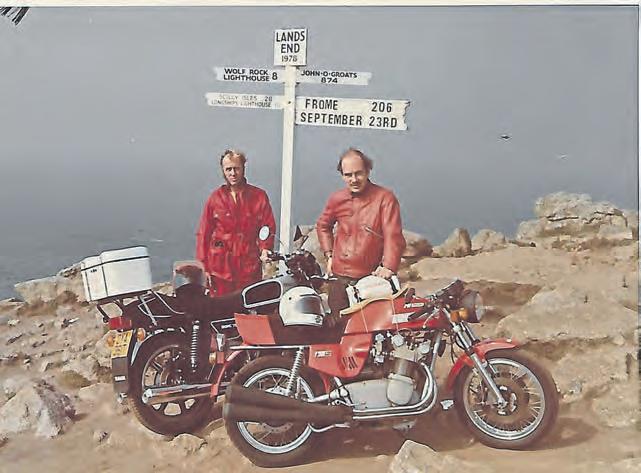

typical of poor Italian paint finish, the window side of the petrol tank and side panel had faded from fire engine red to something like dark pink. Paul had bought the bike on the proceeds of his win at Imola on the 750cc Ducati in 1971, though the MV’s first owner had been one of the Great Train Robbers and the MV had been claimed back by the courts when he was arrested and proven guilty for his crime. I owned and rode it for
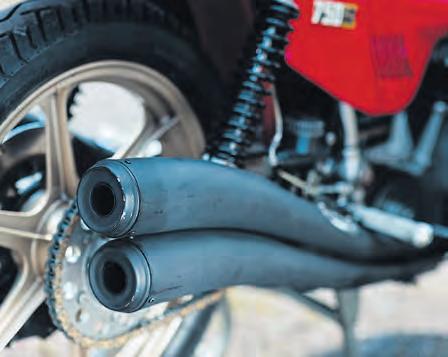
“From any angle, the bright red and silver MV Agusta looks every inch a racer and, with a claimed top speed of 137mph, it was one of the fastest road bikes of its era.”
Red line is at 8500rpm, where peak power is produced. Maximum torque is at 7500rpm.
Just in case you questioned the company provenance… Signature is Giacomo Agostini’s.
Roger Chapman with his MV four.
It was called America, as that was the market its creators hoped to crack.
50 ROAD TEST: MV AGUSTA 750S AMERICA
MV America and Andy Westlake in 1978. Andy’s late brother Rod, with Yamaha triple, behind.
quite a long time, but one of the big problems with all MV fours, due to the engine’s racing heritage, was the firm had difficulty adding an electric starter. The way they got round it was rather Heath Robinson, i.e., they slung a belt-driven combined dynamo/ starter motor under the engine. This worked reasonably well in the dry, but slipped in the wet, and, being a shaft drive with a high first gear, the bike was almost impossible to push start. That said, it looked and sounded wonderful and I loved owning and riding it but, compared to my Honda CB750, it was very impractical.”
I can vouch for the slipping belt on my America and recall a trip to the Shetland Isles in 1979, where I encountered the same problem. The engine wouldn’t turn over, so I went into a ship’s chandlers in Lerwick and purchased an aerosol of belt dressing, which soon had the big four firing into action again.
There is no doubt that the America project called for two basic requirements – style and speed – and on both counts the four-cylinder engine responded well to the challenge. From any angle, the MV looks every inch a racer and, with a claimed top speed of 137mph, it was one of the fastest road bikes of its era. In essence, the 750 America – other than cosmetic features like
the five gallon petrol tank, some decent Aprilia switch-gear, left foot change gear lever, four-into-two exhaust and larger 38mm Ceriani front forks – was similar to the 750S, though there had been a few alterations to the engine. Capacity had grown to 789.7cc, achieved by enlarging the diameter of the pistons by 2mm, giving the new bore and stroke measurements of 67x56mm. The combustion chamber shape was revised and the camshaft lift was increased by 0.2mm to 8.5mm.


The previous 750S had been fitted with 27mm carburettors, but it was discovered that these went out of synchronisation too easily, so the America sported a set of four 26mm Dell’Ortos, operated by a shaft and then a single cable. Not only did the new mounting serve to isolate the carbs from vibration, but there was also the further advantage over the 750S that a single airbox and element were fitted. Further, to conform with US regulations, the America was fitted with a pair of direction indicators.
It was certainly an expensive piece of kit, and when the America went on sale in the UK in December 1976, the on-the-road price was £3187. If your wallet was deep enough, it was possible to pay extra for a full fairing and cast alloy wheels. As already
mentioned, Roger’s bike has been fitted – by Mark Kay (MV Mechanic Verghera) in 2018 – with a Magni chain drive conversion and swinging arm, along with that wonderful set of four ‘silencers’ which are guaranteed to send a shiver down your spine when the Italian icon is fired up. Despite having to operate four carburettors, the throttle on the America is surprisingly light, as is the clutch, but with its high gearing – 57mph in first – it takes a while to get into its stride, but the DOHC engine is very tractable, and I was soon cruising along at the national speed limit. The factory claimed the top speed to be 137mph, but period track tests prove this to be slightly optimistic, with the highest speed

FANCY READING MORE FEATURES LIKE THIS?
If this in-depth look at some seriously gorgeous Italian exotica is your cup of tea, then there’s a very good chance you’re going to find lots more to like in The Classic MotorCycle magazine. It’s carved out an enviable reputation for its considered, classy exploration of the golden age of motorcycling – by celebrating legendary machines, riders and races through lavish illustrations and detailed reports.
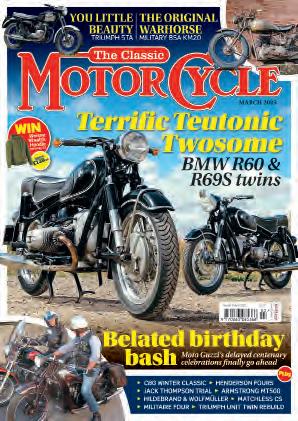



To make it super easy to bag a copy, just scan the QR code here and you’ll be transported to the TCM shop where you’ll be able to get your hands on back issues or preorder next month’s copy before it goes into the shops. It’ll cost you less than the price of a posh pint and you’ll be treated to reams of top-quality motorcycle content that you can’t get anywhere else.

For those without a smartphone, all you’ve got to do is tap www.classicmagazines.co.uk/tcm into your browser and you’ll be well on your way.
recorded at the time around 125mph. Although heavy, weighing in at 518lb (235kg) this is soon lost on the road, as the weight distribution is perfect, making it easy to flit from footrest to footrest. The riding position on the single seat is ideal for a six-foot pilot and the brakes – twin Brembos on the front and a single disc on the rear – are perfect for hauling down from speed.
Roger’s MV – NVB 750R – has Giacomo Agostini’s signature on the petrol tank, and, as I sped along the traffic-free Mendip roads with the evocative wail of the Americas exhaust blasting out behind me, it was those carefree days of the 1970s again, happy days long gone, but never forgotten.
Fairing was an optional extra.
There were less than 1300 road-going MV fours of all kinds built; they are rare.
ROAD TEST: MV AGUSTA 750S AMERICA 51
Four 26mm Dell’Orto carburettors replaced bigger (28mm) versions on earlier incarnations.
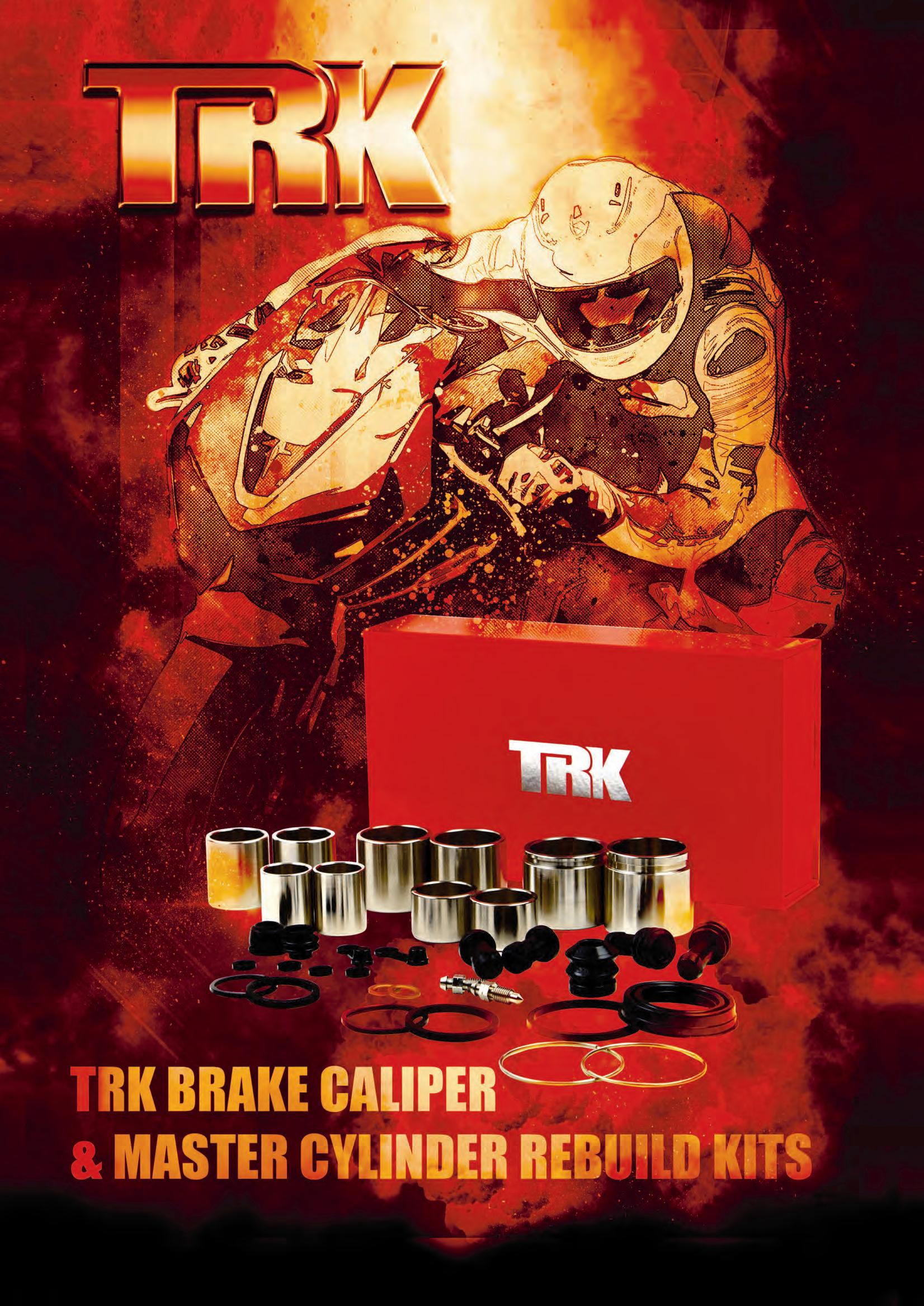
Cost-effective Classics
HONDA CB750 F2N
Four pots, Honda reliability and good looks… all for under four grand!

COST-EFFECTIVE CLASSICS 53
COST-EFFECTIVE CLASSICS
Even if you’re not into classic bikes, you’ll know about the legendary Honda 750/4, the world’s first true superbike. Launched in 1969, it rewrote the rules and swiftly made four-cylinder motorcycles the norm. Honda would go one to deliver liquid-cooled V fours that utterly eclipsed the old CB750 for dead but they still kept faith in the concept. The CB750F2N is arguably the most refined of the genre.
A bit of background
Honda’s V initial fours had met with numerous problems, bad press


and consumer resistance to the point where the model range was dropped and the firm went back to the drawing board. A brand-new VFR750F was launched in 1986 but The Big Aitch also invested in an insurance policy by developing an all-new sports 750cc DOHC aircooled four – just in case. Fortunately the V four 750 proved to be an outstanding, runaway success, which left the poor old CBX750 rather sidelined, sadly. Rather than simply dump the bike, Honda realised it had potential elsewhere outside the sports bike market.
Faults and Foibles
but if you have all the parts it’s not too hard
The bike
Generically referred to as the CB750 F2 or F2N, the bike ran in the UK from 1992 to 2001 and in Nighthawk guise stateside as late as 2003. It was pitched as a do-all machine aimed at riders more focussed on comfort, economy and reliability than outright performance. On paper the bike really didn’t look anything special with just 73bhp and 45lb-ft of torque but numbers aren’t everything. The double overhead cam motor delivers almost seamless power from minimal revs for a super-smooth ride. The seat and riding position are ideal for longdistance work and handling is about as neutral as it’s possible to get.

Once again, in theory at least, the machine doesn’t appear to excel at anything in particular but that’s actually part of the appeal. You can step off the bike after a 300-mile ride and be able to stand up straight without a numb bum. What the bike does is what many Hondas have done since the late 1950s – it performs without issue and is effectively viceless. Some cynics might argue that the CB750F2 is bland but they miss the point entirely. You could
liken the bike to a well-known timber preservative range – it does exactly what it says on the tin!

In terms of servicing and maintenance requirements the bike is a home mechanic’s dream because there’s so little that actually needs to be done! Honda carried over the hydraulic tappets from the CBX750 so one of the biggest spannering chores – valve clearances – is done automatically and continually, thereby keeping you out on the road. The brake callipers might not look like a technical tour de force but they were plenty good enough for the sports CBR600 range they’re borrowed from and work well enough of the 750 here. Because it’s not in a high state of tune, the motor really isn’t under much stress and comes with the added bonus and security of a decent oil cooler, ensuring optimum running temperatures. All ignition functions are electronic so there’s nothing to do there, and the occasional changing of spark plugs is so straightforward using the bike’s OEM tool kit, it makes you wonder why every other bike inline four isn’t equally so user-friendly.
It’s easy to dismiss the latter day
54
1. ENGINE Capable of huge mileages if fed clean oil and filters regularly.
2. STARTER
Poor or unreliable starting can be down to worn brushes in the starter motor.
3. CHASSIS
Nothing bad to report, just look out for stone chips causing rust.
4. EXHAUST SYSTEM Silencers can start to rot from the inside out at their lowest points so worth checking.
5. BRAKES Sliding calliper-ype units that benefit from the occasional strip and clean.
6. TRIM Plastics around the seat can break at their mounting points
to repair.
1 2 3 4 5 6 7
7. ELECTRICS Regulator/rectifiers are mounted to the left of the headstock and covered with a plastic shroud which inhibits cooling. After-market replacements are good and a few slots cut into the shroud will aid cooling.
It proved surprisingly tricky for us to get our hands on photos of the lesser loved F2. Thankfully, Steve Cooper was on hand with snaps of his funky faired version from a few years back.
750/4 as possibly dull and dowdy, but it comes with the legendary Honda build quality and will keep on running when many of its peers have been recycled into white goods.


Sure, it’ll never set the world on fire but not everyone wants an uncompromising missile. Just like Yamaha’s first XJ600 and XJ900 the Honda ploughs a different furrow and steers well clear of pretending to be something it isn’t.
At the time of its launch much was made of its market rival the Kawasaki ZR7. The press of the time reckoned the ZR had the edge but how many of them do you still see around?

Precisely!
Lineage and Legacy
The final CB750F2s were offered in Japan only in 2007 in 70s AMA racing colours. After that the bike was withdrawn from sale, probably because it couldn’t meet evertightening emissions regulations. What replaced it? Nothing really because technology had moved on and most modern twins could probably meet or exceed the old bike’s abilities. Probably the closest you could get to the old bike’s raison d’être would be Honda’s NC700 but it really doesn’t have the old-world charm of a CB750F2!
Summary
Essentially a ‘cheap as chips’ generalpurpose 750 that won’t break the bank to buy, run or service. Also comes with Honda build quality so easily outlasts its peers. Infinitely better than its detractors would have you believe, who generally have never even ridden one! Once sampled you might fall under the F2’s spell – they really are rather good.
Why you might want one now
Price has to be a major reason for wanting a CB750F2 as they are almost silly cheap. They offer a lot of what the earlier 750/4s of whatever vintage had but without the hassles and worries of running an older Japanese classic. And, of course, spares should you need them, are much more readily available. Why else might you want one? Well… the bike has old-school looks and style in spades with Honda dependability and late 1990s technology – what’s not to like?
Typical prices
Firstly be aware that the CB750F2 is also a model designation of the earlier SOHC from the late 1970s. Our featured bike is similarly a CB750F2 but can sometimes appear

as a CB750F2N just to muddy the waters! A decent example will almost emphatically be around £3500-£4000 and dealers asking in excess are generally having a laugh. Most bikes currently for sale seem to have between 3000-14,000 miles on them and frankly even at 20k there will be no appreciable wear inside the engine. Therefore buy on overall condition and not on mileage. There was a UK dealer special model equipped with an aftermarket fairing; apparently it was fitted to old stock models that hadn’t been sold. Don’t pay extra for this ‘feature’ unless you really want a fairing and know that if you remove it you’ll have to find the OEM headlamp bracket which won’t be cheap.

COST-EFFECTIVE CLASSICS 55
QUICK SPIN: BSA GOLD STAR
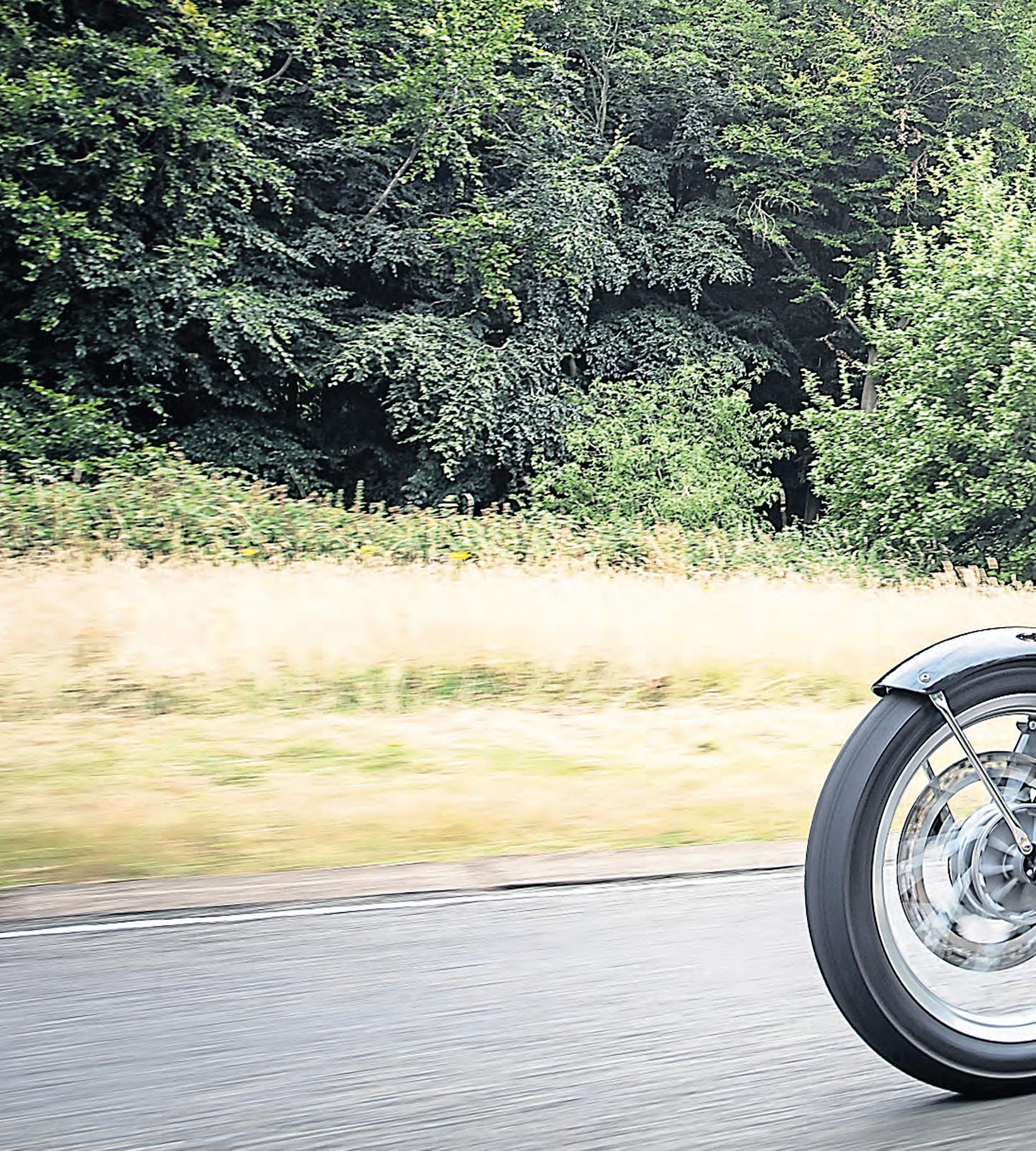
BSA is back. Despite the 50s and 60s glory days (one in four bikes was a BSA) a trading deficit of £3 million was recorded in 1971. BSA closed for good in 1973.
When the Mahindra Group purchased the company there could be no other name for its first bike but the Gold Star (the original name came from 1937 when Wal Handley was awarded a Gold Star badge for lapping the Brooklands circuit at over 100mph on a BSA Empire Star.)
Give me some spec
A 652cc, single-cylinder engine putting out 45hp @ 6,500rpm with maximum torque of 55Nm @ 4,000rpm is housed in a tubular steel double cradle frame with box section swingarm. Top speed 103mph (est). Seat height is 780mm. Hauling up the 213kg (wet) weight is a 320mm single floating disc with Brembo twin-piston floating calliper and single 255m rear disc with single-piston Brembo floating calliper.
Changes from last year’s model
Brand-new model for 2022/23.
So what is it like to ride?
At the launch on the Millbrook test track (nice nod to the original’s racing heritage), testers loved the Gold Star’s easy-going nature: ‘peach of an engine’and soft, yet composed, suspension. How does that translate to the UK’s pothole-strewn roads in February?
It’s superb.
It’s so easy to get on with. Sat upright, feet and hands in a neutral position, ‘controls fall easily to hand’ (couldn’t resist). It’s balanced (once riding for a while, lowspeed bimbling was simple). The relatively light clutch and slick,
positive box make town work easy. Open up, the engine surprises. It picks up speed quickly, getting on with the task. Overtakes are a doddle; twist the throttle and it punches hard (even at motorway speeds) past your victim. Handing isn’t sportbike sharp but goes where you point, though at motorway pace it’s harder work. Up to the 60s it’s fluid, letting you flow from corner to corner.
Suspension is firmer than the launch reviews suggest (though it bottomed out a couple of times). There is a fair amount of fork dive under firm braking; get that out the way early when approaching a bend. Talking brakes, they’re just about right for the Goldie but do appreciate a firm squeeze.
The tiny mirrors work better than they deserve. I like the warning light placement on the headlight cowl, leaving the clocks to give feedback on the important stuff. My only gripe? The broad seat and peg placement. Great on the move, but coming to a stop I had to splay my (admittedly short) legs wide to touch down.
But you can live with that. BSA has got it spot on with the new Gold Star. It can do anything from commute to motorway (but you’re pushing the handling), though the dealer told me bikes sold so far have gone to homes with another bike or bikes. The middleweight retro arena has gained a serious contender for the crown.
How much does it cost?
£6,500 for the Highland Green base model (£6,800 other colours). There is a chrome ‘Legacy’ edition for £7,000.
56 QUICK SPIN
WORDS: Bob Pickett

WANT TO RIDE? To test this bike contact: Johns of Romford Motorcycles 46/52 London Road Romford Essex RM7 9QX Tel: 01708 726049 or 01708 761047 Email: rushgreen@johnsofromford.co.uk Web: www.johnsofromford.co.uk QUICK SPIN 57



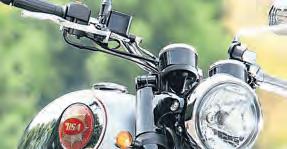
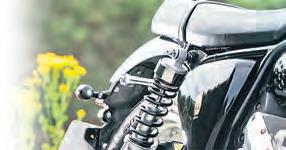









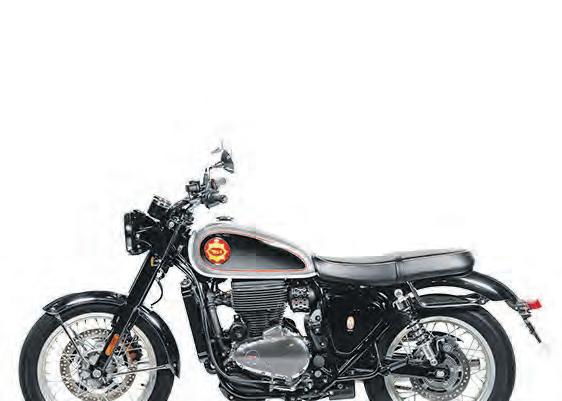








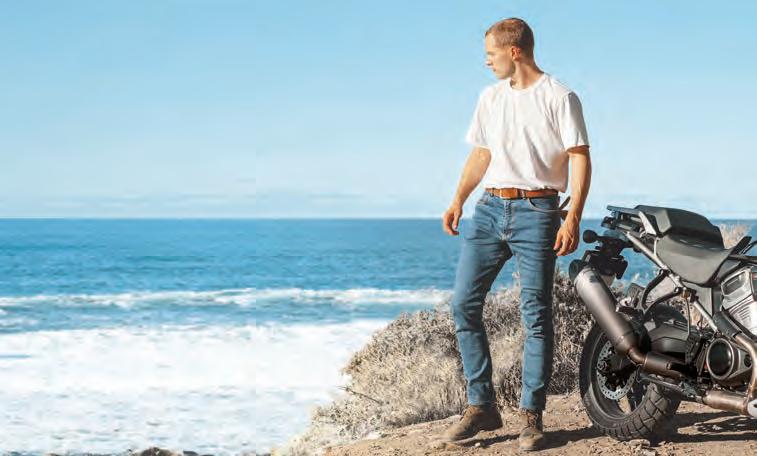









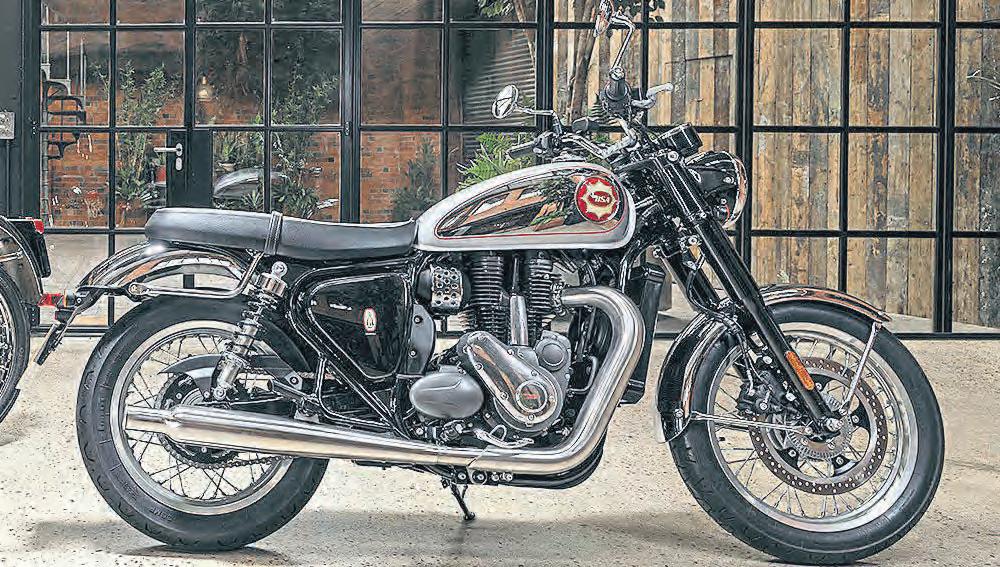








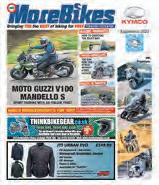


WINTER WARMER
How Gerbing’s heated gear kept Ross Mowbray toasty on a sub-zero slog across the north
Keeping warm when you’re on two wheels in winter can be a bit of a challenge. I’ve done my fair share of rides cursing myself for not being better prepared for the cold. But now I’ve got no excuse, because I’ve got my hands on a couple of bits of heated gear from Gerbing which have stopped me shivering on some seriously chilly treks.
I’ve tried my share of heated gear over the years, and I’ve always loved it – but the nature of the job and the amount of swapping and changing between bikes sometimes means that wiring it in and getting the chance to use it on a regular basis can feel like a bit of a faff. But back in December I had Suzuki’s GSX-S1000GT for a month, and with a couple of big rides planned (including the one featured on page 23), I had the perfect opportunity to live with and get to know Gerbing’s flagship gloves and heated jacket liner.
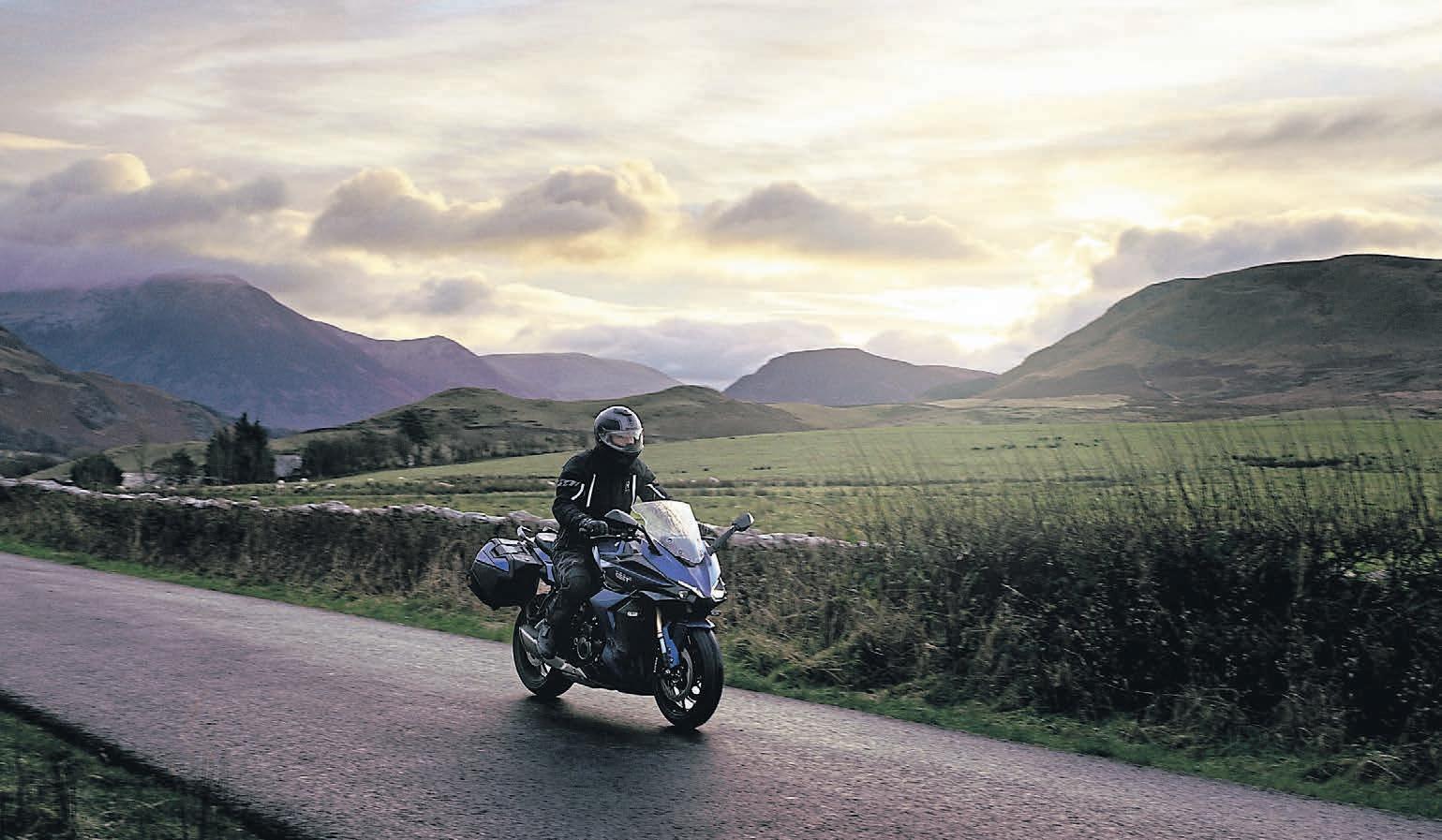
I know plenty of you are sceptical about heated kit. I’ve had conversations with hardened bikers who gently mock those who can’t handle the cold, but I can pretty much guarantee that they’ve not tried it out for themselves, because in all honesty, it’s an absolute game changer. Okay, so if it’s sub zero and the wind’s blasting into you, you’re probably not going to be sweating, but I know for a fact that these two bits of kit will make the world of difference and make the ride a whole load more enjoyable when you’re not shivering your knackers off
Let’s start with the jacket. It’s a sharply designed, snug fitting bit of kit that’s made to replace your existing jacket liner – but which has the added bonus of over 35 metres of wire which distributes a nice, even spread of heat through the chest, back, collar and sleeves. It’s lovely to wear –comfortable and not bulky at all (despite the technology that’s packed inside). You could easily stick it in the bottom of your rucksack and whip it out when you need it. And it’s also waterproof, so you don’t need to worry about it getting damp and going kaput.
It's also super-easy to use with a whole host of Gerbing’s other heated biker kit. There’re three input connections which sit neatly inside one of the front pockets and can be wired into a temperature controller. The first plug draws power for the heated jacket liner; another draws power for Gerbing’s heated gloves (the jacket already has the wiring for them stashed neatly down through the sleeves to a pair of zippable pockets on the cuffs); and the final one can be used to connect a pair of Gerbing’s heated trousers or heated socks. Seamless stuff. The controller is easy to use, too, and depending on how many additional bits of

heated kit you plan to use, you can buy a controller which lets you dial in the heat settings individually.
The gloves are arguably even more impressive.
They’re a quality set of bike gloves in their own right, made from soft 0.6mm premium full aniline leather and featuring hard knuckle impact protection, a plush Thinsulate liner for warmth and comfort, and a Hipora liner which helps make them waterproof, windproof and breathable.
They’re pretty toasty to start with but add in the new and improved Gerbing XTREME heating technology and you’ll be laughing. They’re so potent that the hottest setting for the gloves is actually deactivated when they arrive. You’ll have to check out the instruction and permanently activate them if you think you need it. That said, it’s easy enough to cycle between the heated settings using the integrated push-button controller that sits neatly on top of the gloves. You can even press it on the move if you need to up the temperature a touch. Oh, and there’s even a visor wipe built in to make it straightforward to shift any road gunk that’s been chucked your way.
It's also worth mentioning that if wiring in isn’t for you and you’d prefer to be mobile, Gerbing's
Gerbing Premium Heated Jacket Liner £199.99

Gerbing XRL Xtreme Heated Motorcycle Gloves £189.99

liner and gloves can also be powered by batteries. I’ve no idea how well they perform, but given the firm’s track record, I suspect they’d be more than up to the job of keeping you warm during a long, cold day in the rider’s seat.
I’ve been blown away by these two top bits of heated kit from Gerbing. They made an absolute world of difference on my icy slog from coast to coast through the Lakes, Dales and Moors in near-freezing temperatures. It was never going to be a wholly pleasant journey, as I tiptoed my way away from icy St. Bees, but with my core toasty and my hands as protected as possible, I had a far better time than I expected, and returned home without frostbite and a new appreciation for the value of heated gear. I’m a changed man and have already taken them off the Suzuki and wired them into my next ride that’s going to be my main steed for the next few months.
If you want to know even more about Gerbing’s gear and check out the other bits and bobs in its range, visit: www.gerbing.co.uk
TRIED & TESTED 59
TO THE MAX
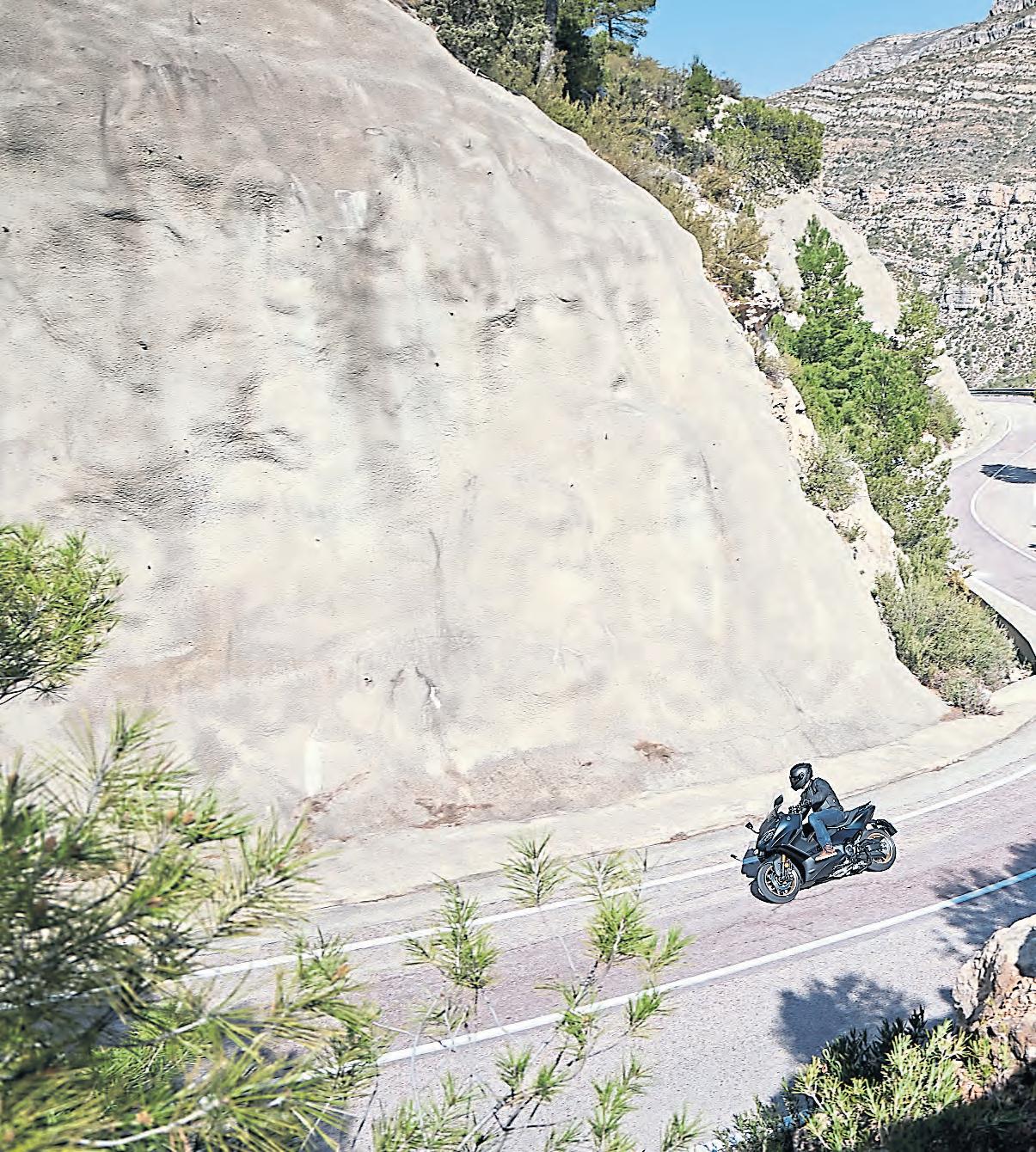
60 LAUNCH RIDE: YAMAHA TMAX TECH-MAX
Yamaha has updated its tech-rich scooter for 2022
The TMAX has been in Yamaha’s range since 2001, and in that time it has sold 350,000 units worldwide.
Unsurprisingly, 85 per cent of those were sold in Europe, mostly in France, Italy and Spain, but there is also a following for the scoot in the UK.
For 2022 the TMAX received an update, and the latest incarnation was the eighth generation. This time the Japanese factory had been working on the scooter for three years, and felt confident that it had been improved in many ways.
Only the Tech Max version of the TMAX will be sold in the UK, but given that the vast majority of the units sold so far had been the Tech Max variants, that’s neither a surprise to anyone or a problem for Yamaha.
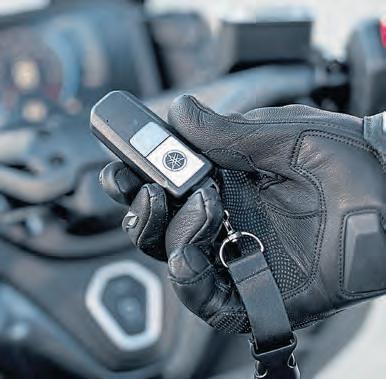
To see what the key selling points of the new model are, and more importantly, how it rides, we took one for a spin in Valencia.

What is it?
There are a few key characteristics of the target customer for the TMAX that Yamaha considered when the latest version was conceived. The customers are likely to be males of around 35-45 years old, most of whom are repeat customers looking for a high-end scooter for both commuting and weekend trips. The sum total of all that is a customer who wants a top-quality scooter and, crucially, is willing to pay for it. This is key as the TMAX Tech Max has a pretty hefty price tag of £12,500. Sure enough, you get a lot of tech, refinement and sporty character for the money, but it’s not a budget option by a long shot.
The new model is a combination of brandnew as well as tried and tested. The engine, for example, is the same 562cc parallel twin as before,
with maximum output of 47bhp at 7500rpm and 55.7Nm at 5250rpm. The CVT belt transmission has also remained the same. The ride-by-wire system is new, and enables two ride modes, touring and sport, that both offer full power.
Slight change from the previous generation is that the suspension, although utilising the same hardware (USD forks and linked rear shock), has new settings.
But it’s not all old news – plenty has changed, too. One of the new additions is Yamaha’s lightweight aluminium Spin Forged wheels as seen in the MT range in 2021. They reduce inertia by 10 per cent at the front and six per cent at the rear. The wheels are dressed in new Bridgestone Battlax Scooter SC2 rubber.
The windscreen is new, too. Yamaha says that it has improved airflow, reduced wind pressure at high speeds and manages to offer better acoustics with the new screen. On the Tech Max, the windscreen is electronically adjustable.
There has been a slight adjustment in the riding position, with the new forged aluminium handlebars, longer footboards and a three-step adjustable backrest in the seat putting the rider in a tad more of a forward-leaning, sporty riding position.
Security is enhanced with a new smart key and a centre switch that can be used to lock the steering and centre stand in place. The fuel cap is keyless and locks automatically two minutes after the ignition is switched off
An important upgrade on a machine that wants to offer you the best of tech available, is the new 7-inch full TFT dash and phone connectivity. You can control dash themes; vehicle information; machine settings; heated grips and seat; cruise control; electric screen; as well as the phone-related

LAUNCH RIDE: YAMAHA TMAX TECH-MAX 61
WORDS: Mikko Nieminen PHOTOS: Yamaha
functions such as music, calls, weather and Garmin navigation through the new back-lit switches.

The range of updates to the TMAX Tech Max is completed with the new aesthetics. The aim was to make the scooter as compact as possible, while giving it an optically higher centre of gravity and slimmer waist. The latter is not just about the looks, but also means that it’s now easier to get your feet to the ground. There are also new projector LED headlights, and a T-shape rear light. The colour options for the Tech Max are either dark petrol or grey.
Town riding
Scooters are a big thing in Spain. They are everywhere, and they are ridden by everyone from spotty youths to little old grannies. It’s lovely to see.
Spain is also the third biggest market for the TMAX behind only France and Italy, so it was a natural location for the launch test ride.

The only problem was that the new scoots were getting so much attention from the public, that when I was doing a little video about the TMAX at the side of our hotel, I got interrupted three times in 10 minutes by people wanting to know more about the machine. But it’s not every day that bikes get such attention, so I was happy to chat.
The test ride itself was a little over 100 miles long, being a mixture of town, highways and backroads. It was a good route to see how the TMAX handles both commuting and leisure riding.
We started in urban Valencia, so the city commuting element was
tested first. And it was a strong start for the scoot. As soon as you set off on the TMAX, you appreciate the keen power delivery from the twin engine. It’s ‘only’ a 562cc machine, so it’s not too much of a handful, but the acceleration is rapid. The CVT transmission means no gear changes, and because the traction control system is there to help you if needed, you can just open the throttle and not let go until you have left the traffic behind, which doesn’t take long.
The TMAX is a bit bigger than a city scooter of smaller capacity, but it doesn’t feel too big to fit through gaps or too heavy to weave in and out of traffic. And being a bigger capacity machine, you get the muscles that smaller scooters miss.
Highway cruising
Those muscles were particularly appreciated when we moved from town to highways. The TMAX is perfectly happy to cruise at motorway speeds, and even from there, there is still enough left for overtakes.
Comfort in faster speeds was good, too. I had kept the new electronically adjustable screen in the low position in town to let more air in through the helmet vents, but as the speeds increased I lifted it to the high position (easily done with the joystick switch). The airflow was nicely directed away from my body, and there was not much buffeting around
the helmet. I was impressed.
The riding position was comfortable, too, with plenty of room for your feet to either be flat on the boards, or more forward for a cruising feel. The adjustable lumbar support on the seat was also good; I moved it to the forward-most position to be able to lean on it, and I felt perfectly planted in the seat.
The cruise control is easy to use with its dedicated buttons on the left side of the bars, and it makes longer journeys that little bit more relaxed.
In town I had been in Touring ride mode, but on the open road I tested the Sport setting, too, soon settling for it for the rest of the ride as it didn’t feel too aggressive at all, just added a bit more immediacy to the connection between the twist grip and the back wheel.
So far, the ride was going well. My only complaint was the heated grips. Together with the heated seat, they are standard fitment on the Tech Max, which is great, but unlike the seat that felt red-hot on full blast, the grips were lukewarm at best, even when on the maximum setting. If they weren’t warm enough for a ride in Spain, they are unlikely to cut the mustard in the UK.
Getting sporty
After the highway cruising we moved on to winding mountain roads. This is probably not the most natural
habitat of the TMAX, but given its aim to please both commuting and leisure riding customers, it needed to handle the twisties, too. And it did. Surprisingly well.
The backroads complemented the agility of the scooter. It doesn’t have the widest of bars, and I wasn’t sure how much leverage they would provide, but the scooter is quick turning, and changes direction easily, which makes it very entertaining on twisty roads. Combine that with great suspension action, and the TMAX negotiates corners with a calm and confidence-inspiring way. You can ride it much harder than you might think a scooter can handle.
But this is a scooter, and if you get too excited by what is possible, you will start to see the limitations, too.
First limiting factor is the ground clearance, with the centre stand scraping the Tarmac when you lean into a corner too sportily. It is easily done as the Bridgestone tyres offer good grip and the firm suspension holds the bike well in corners. You just need to have a word with yourself before anything else starts to scrape.
To help keep things calmer, the brakes work great. They are not the sharpest, but have plenty of stopping power, and if you grab a bit more of a handful of the brakes than is good for you, the ABS will kick in.
The only version of the TMAX that will be available in the UK is the Tech
62 LAUNCH RIDE: YAMAHA TMAX TECH-MAX
LAUNCH RIDE: YAMAHA TMAX TECH-MAX 63

TECH SPEC
Yamaha TMAX Tech Max
Price: £12,500
Engine: 562cc parallel twin
Power: 47bhp @ 7500rpm
Torque: 55.7Nm @ 5250rpm
Transmission: CVT, belt final drive
Frame: Aluminium die-cast frame
Suspension: 41mm USD forks, linked-type monocross rear shock with preload adjustment
Brakes: (F) 2 x 267mm discs and radial fourpiston callipers, (R) 282mm disc, single piston sliding calliper
Wheels: 15-inch aluminium wheels
Tyres: Bridgestone Battlax Scooter SC2, tubeless, (F) 120/70R15M/C 56H, (R) 160/60R15M/C 67H
Seat height: 800mm
Fuel tank: 15 litres
Fuel consumption: Claimed 58.8mpg (20.8km/l), tested 56.4mpg (20km/l)
Kerb weight: 218kg
Service intervals: First at 600 miles, then 6000 miles or annually
Roadside recovery: 2 years UK cover, extendable by 1 year for free
Warranty: 2 years, extendable by 1 year for free
Contact: www.yamaha-motor.eu/gb/en
Max version, and there really is a lot of tech on offer. The centrepiece of the scooter is the new 7-inch full colour TFT dash. It is nicely laid out with all the key information easily readable. Menus for more functionality are easily negotiated with the joystick in the switchgear. The system is easy to figure out, navigate and customise to your linking – the whole user experience is very intuitive.
The bike can also be connected to your smartphone via a couple of apps, and once that’s done there are the usual phone functions available, but also Garmin-based satnav displayed on the TFT dash. It works well, although I would have liked it to be a little bit larger for easier navigation.
Away from the shiny apps and phone links, my favourite tech feature of the bike is that when you put steering lock on, the centre stand is also locked in place to make moving the bike more difficult. It’s a simple but effective solution.
The keyless key is also one of the better ones. You can not only start the bike without the key, but the fuel cap is also keyless, so you don’t need the key for refuelling. There’s also a button to open the seat to access the

storage, which is big enough for one full-face helmet and a small bag, so no need for a key there either. One place that I wish had had a lock was the little glovebox where you can put your phone for bike connection.
Verdict
I will be interested to see how well the TMAX does in the UK sales charts. Big scooters don’t tend to sell silly numbers here...
One sticking point will be the price: £12,500 is a lot of money for a commuter that can boogie. Yamaha seems confident that there is enough of a following for the TMAX, and that the level of tech and quality components justify the price. But when you consider that Yamaha’s own Tracer



9 GT is only £12,300, and the Tracer 7 GT a mere £9050, people new to the joys of maxi-scootering might think twice. The Tracers both lack a lot of the features of the TMAX, but offer a lot of value in other ways.
However, if you are after a maxiscooter, the TMAX Tech Max is setting the bar pretty high in terms of equipment. And when a scooter is this much fun to ride, it deserves to do well in terms of sales, too.
Closest rival Kymco AK550 – £9899
There are not many competitors in this engine category, the closest rival probably being the Kymco AK550. It has a 550cc twin engine with 52.7bhp and 55.6Nm on offer, which is pretty close to the Yamaha. The tank has the same 15-litre capacity; the wheels are the same 15-
inch jobbies; but the Kymco is a fair bit heavier with a dry weight figure of 226kg. The Kymco also boasts phone connectivity, but the dash is not in the same league with the big TFT one on the Yamaha. What the Kymco does have in its advantage is its price – it’s £2600 cheaper.

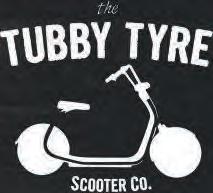




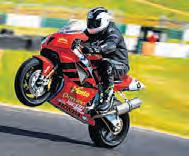
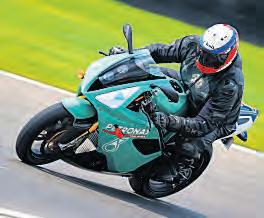




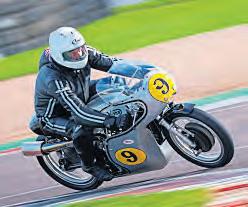

























TEST RIDE: ZONTES ZT350-GK 65

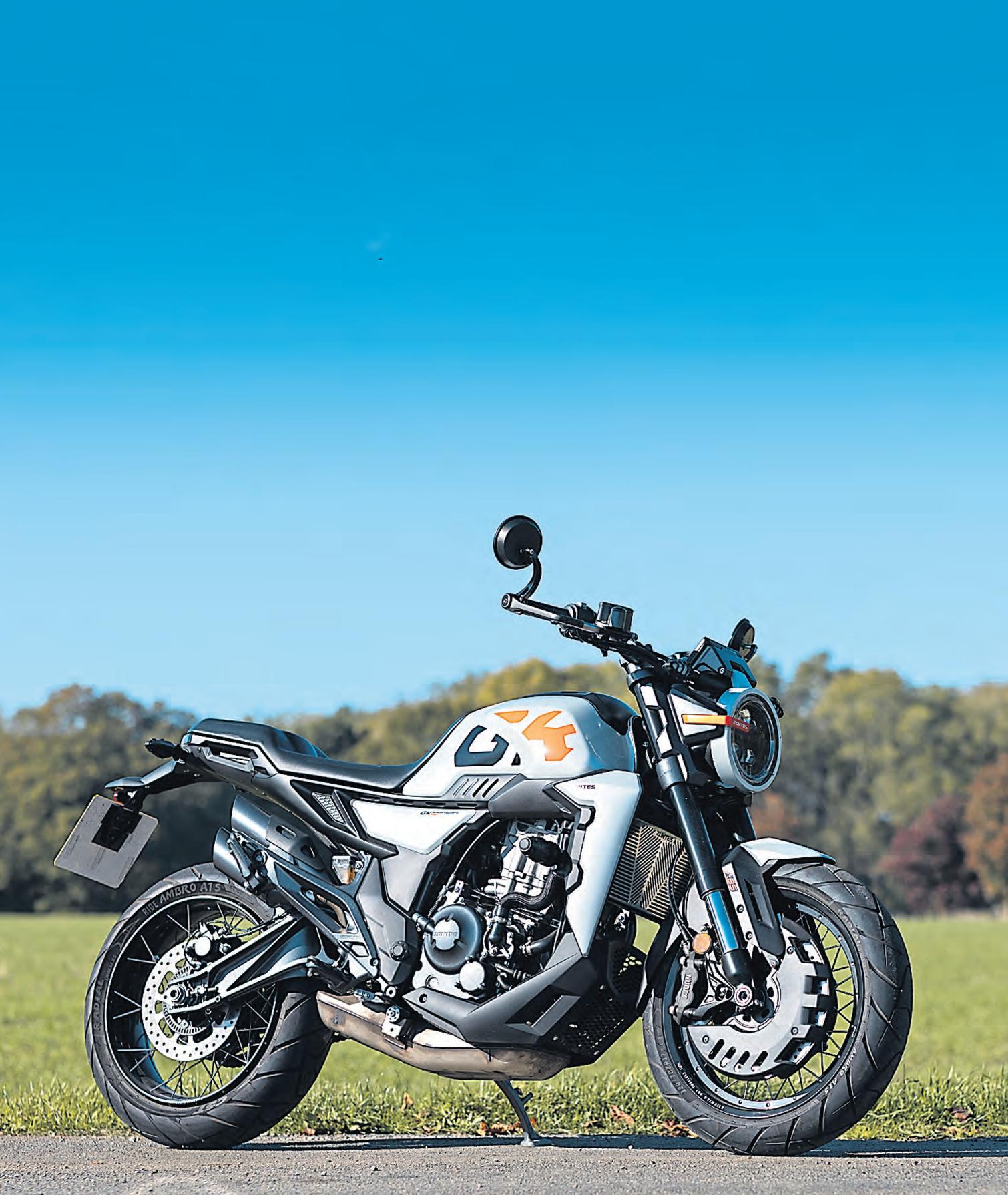
NAKED AMBITION
Is this funky roadster from China worth a look?
WORDS: Simon Meyer PHOTOS: Gary Chapman
Make no bones about it, Chinese bikes are getting better. A lot better. A vast array of firms have been manufacturing bikes, engines, parts and accessories that are being lapped up by western customers in great numbers. One such factory is Zontes.
It’s been selling in Europe since 2009, and over the last few years has built up a pretty decent reputation for its bikes that neatly balance quality and price with a focus on value for money rather than outright low cost. The current generation of models are better than ever before – and while they might not quite match up to some of the more established Japanese and European competition, there’s plenty to like about its diverse model range of 125s, 310s and 350s.
We recently got our hands on one of its flagship models, the funky ZT-350GK, and took the chance to put it through its paces over the course of a few weeks. Here’s how we got on.
First off, there’s no denying that the Zontes ZT350-GK is a great-looking bike. Blending retro
scrambler and conventional naked bike styling into a lean, mean package that’ll turn heads wherever you go. That’s a good start, right?
Okay, so the first thing that you need to do is unlock the bike. To do that, just make sure the remote key is in range and tap the lock/unlock button to release the digital steering lock. To lock it, you simply turn the handlebar and push the button until you hear the lock engage. There’re even separate buttons for the fuel tank and the seat. They’re nice touches, that help the Zontes feel pretty premium.
The quality of a bike’s lights is an important consideration, especially at this time of year. The good news is that the GK comes equipped with a great set of lights. The large auto-levelling LED front headlight is fantastic and really bright, proving itself more than capable of illuminating the road ahead. There’re also LED indicators and an LED rear light.
The dash is a TFT full-colour number, which again helps the Zontes feel like a top bit of kit. These are the sort of things that can make a bit of a difference to potential punters, and with four different display styles to cycle through, plenty of information (including the always welcome gear indicator), and the ability to hook it up to your phone to screen share navigation, flick through your music and answer your phone (when used in conjunction with a communications system), the bike’s as well kitted out as any number of much more expensive machines from some of the biggest names in the game.
The dash also makes it easy to see which of the two rider modes you’re in – either E for Eco or S for Sport.



To flick between them, it’s a simple and straightforward tap of a button on the right handlebar. There’s no mucking about in sub-menus to fine tune either – Eco mode slightly limits

performance and helps to save fuel, but if the engine goes past 7,000rpm then it’ll automatically switch to the more aggressive, full-fat Sport mode. And it goes pretty well. While it might ‘only’ be a 350, the GK has plenty of punch to make good, solid progress and has enough in the tank to dispense with slower moving traffic quickly and efficiently. It really is a great little bike to ride. In fact, I’d probably say it feels like a small bike that’s had a bigger engine fitted. Which is certainly no bad thing in my book.
Most of my miles on the GK were as part of my daily commute to the office. It’s only 20 or so miles, but it takes in wide-open fast A-roads, tight and twisty sections, heads up and over hills, around roundabouts and passes through towns and villages (offering opportunities for cutting through traffic). Essentially, it’s the perfect route to put a bike through
its paces. And the compact little Zontes held its own. I had a blast flicking through the corners, nipped past lorries with ease and never once struggled to get up the steep inclines. The pokey 348cc watercooled single cylinder motor kicks out a respectable 38bhp at 9500rpm, which is more than enough to put a smile on my face. The six-speed gear box is slick and responsive, making it simple to flick through the gears and get the most out of the engine. And despite working it hard, I didn’t have to stop for fuel all that often either –
66 TEST RIDE: ZONTES ZT350-GK
that’s because the GK comes with a whopping 17-litre fuel tank, which means you’re good for well over 200 miles before your next trip to the petrol station.

It stops well, too, thanks to the large single 320mm disc up front and the 265mm disc at the rear. The gripping’s looked after up front by a radial-type four-piston calliper produced by the popular and proven Spanish firm J. Juan, and it also boasts a plastic shield that you wouldn’t usually find on a bike like this. Oh, and there’s also a quality dual-channel Bosch ABS system. It’s a godsend when the roads are greasy and the conditions are less than favourable, but in truth I never once troubled it.
The suspension set up’s pretty good, too. The 43mm USD forks are strong and capable, while the centremounted monoshock (which uses a high-pressure nitrogen cylinder with 50mm damper body) offers a good balance of comfort and performance. It probably sits slightly towards the stiffer end of the spectrum, but it still proved itself more than capable of soaking up and smoothing out smaller bumps in the road. And despite that stiffness, I found it pretty comfortable. The seat is good – and even on longer rides I had no aches or pains materialise.
What don’t I like? Well, I’m not the biggest fan of the bar end mirrors.

Vibration from the single cylinder motor made it fairly difficult to get a clear, undistorted view when the bike got up to speed. It’s a pretty common problem though – and there’s probably very little Zontes could do to solve the problem once and for all. Another thing to mention is the electric steering lock. I didn’t have any issues, but my colleague nearly dropped the bike after it locked on him unexpectedly. If the button is pressed and the steering is not put into a position where it can lock, then it’ll wait until the next opportunity.
I’m sure that if it was your own bike, you’d very quickly get used to it, but I’d be remiss for not mentioning that it nearly caught us out.
I really like the GK. The funky retrocum-naked looks good, sounds good and is pretty perfect for those who are working their way up through the licence categories and who want something slightly different that’s capable and cool but still affordable.
I know Chinese bikes aren’t exactly renowned for their build quality, but the Zontes actually looks pretty good, and I’d be fairly confident it’d stand the test of time with a bit of looking after. I know plenty of you will be sceptical about the Zontes ZT350-GK, but if you’re in the market for a new A2 friendly bike that’s fun to ride and great to look at, then you should go out and try one for yourself.

TECH SPEC
Zontes ZT350-GK
Engine: 348cc watercooled DOHC single
Power: 38.8bhp (29kW) @ 9500rpm
Torque: 24.1lb-ft (32.8Nm) @ 7500rpm
Transmission: Constant mesh 6-section
transmission
Frame: Steel
Suspension: (F) USD forks (R) Monoshock with high-pressure nitrogen cartridge
Brakes: (F) 320mm single disc and J.Juan radial calliper (R) 265mm single disc and J.Juan radial calliper / Dual Channel Bosch ABS
Tyres: (F) 120/70ZR17 (R) 160/60ZR17
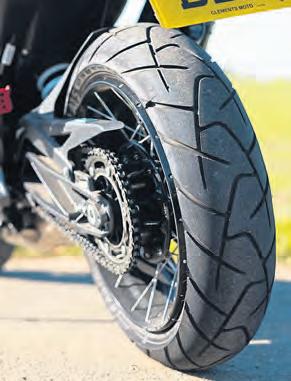
Fuel tank: 17 litres
Fuel consumption: 88.2mpg (claimed)
Seat height: 795mm
Weight: 188kg
Price: £4499 + OTR
Contact: www.zontes.co.uk
TEST RIDE: ZONTES ZT350-GK 67
Biker Friendly Guide





So now you want to be out and about, riding those roads, feeling your bike run beautifully and watching those bugs splat on your visor. On your own or as part of a group, it’s what we live for.
We’re sure you will have your favourite route, but if you are looking for a few ideas on where else to go, what to do, where to chat to like-minded folk and perhaps just have a great brew at a place which guarantees a warm welcome, then these are the pages for you.





You can always find some interesting roads to and from any of these great venues, and it’s also worth bearing in mind that when you get there, chances are you’ll find some fellow bikers keen to chat about your machine, your route... and share their own experiences too.
As you can see from the map, there are cafes, bars and venues all around the UK which are perfect for a visit.
So go on, support these venues which love their bikers... get out there and pay them a visit, you will not be disappointed!




1 2 4 5 6 3 3 4 5 6 7 1 2 7
NEWBIKESALES


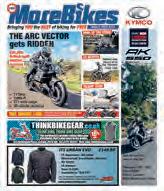
























































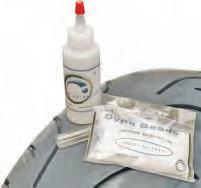










CLASSIFIEDS
SERVICES
WEBWATCH ACCESSORIES TYRES CHROMING
For Sale
AMBASSADOR MOPED 50cc, 1962, believed to be one of only 4 known to exist from a build of 200, good condition, V5, on Sorn, £1100Tel.07790603367.Worcs.
ARIEL HUNTMASTER 1958, concours condition, following extensive refurb, matching number, old buff logbook, original restoration, V5C, 51,000 miles, 12V electrics, photos available, ready to ride, free delivery arranged, £6450 Tel. 01723 372219. North Yorkshire.
BIMOTA TESI ID 1990 original throughout, 300 miles from new, onlymade127,Ducati851engine, very rare bike, offers Tel. Martin 01243 868464. West Sussex.
HONDA BROS 1985, 400cc, all MoT’s, 14,000kms, run every month, hardly used, getting a bit heavy now, need a 125 Honda or Yammy, as new, £1750 ovno Tel. 01515 310111. Merseyside.
KAWASAKI KLR650 Tengai, 1989, complete rebuild from the ground up, full engine rebuild new paint, very nice usable classic, £3250. Tel. 07801 502033.
HONDA CG125 1991, model done in a Cafe Racer style, 12 volt electrics with CDI ignition, bike is currently on Sorn, V5C is in my name, £850 ono Tel. Syd 01229 465311; 07939 430576. South Cumbria.
ROYAL ENFIELD 250cc




WATSONIANSQUIRE Motorcycle trailer, blue, fibre-glass body, new tyres, new inner tubes, new lights, can send pictures, £450. Tel. 07704 343331. Stockport.
HONDA CB100N 1983 model, original registration number for the bike has been recovered and I have V5C in my name, frame, swinging arm and ancillaries have been shotblasted and re-painted, wheels have good chrome, respoked, new tyres and tubes fitted, Speedo is not original so cannot verify the history of the bike, £1250 ono Tel. Syd 01229 465311; 07939 430576. South Cumbria.
HONDA XBR 500G 1986, very reliable, starts first kick or button press, extras 4,5000 miles, used regularly, owned for 6 years, MoT, £1300 Tel. Jerry 01626 772270. Devon.
TRIUMPH TRW 1957, 500cc
sidevalve in superb restored condition, lovely lightweight post war military bike, V5C, £6995 Tel. 01895 624554. Herts.
Clipper, 1959, silver/black, paintwork chrome guards, very tidy throughout, lightweight, single cylinder, new battery, excellent wheels & tyres, photos available, V5C, historic free road tax, free delivery arranged Tel. 01723 372219. North Yorkshire.
TRIUMPH Daytona 750, 1993, quite a rare machine, only 300 were made, excellent condition throughout, only 4 previous owners, much work done over the winter with a £600 parts spend, runs and rides really well, ring for full details, MoT, 63,000 miles, £2500 Email. niccollotto@gmail.com Surrey.
YAMAHA V80 89cc, 1983, restored, new wheels, exhaust, seat, fairing stunning condition, classic investment or ride, £22 road tax, 100+ mpg, MoT free Yamaha answer to rusty C90, £195 Tel. 07434 072785. Lancashire.
YAMAHA XT225 2003, good condition, blue, air cooled, 4 stroke, reliable economical, new tyres, available April as in storage, MoT, £2500 can email photos. Also available Kawasaki KMX125, needs work, £850 Tel. 07447 510868. Lincs.
Parts For Sale
YAMAHA FS1A 2008, new clutch springs, unused, clutch lever/ cable, cover gasket, all new, £25. Kawasaki ZZR600, 1993 on stainless front down pipes, 2 aluminium silencers, £100, 2 front discs, £30 Tel. 07758 515696. Lincolnshire.
YAMAHA TRACER 700 2018, Nitron uprated rear shock as new, cost £500 accept £250 +p&p Tel. 01539 725198. Cumbria.
Wanted
CLASSIC MOTORCYCLE wanted any make or age from a box of bits to a mint machine British or Jap, decent price paid Tel. Colin 01514 470147.
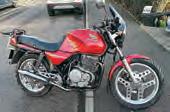

CLASSIC MOTORCYCLE wanted in any condition by genuine enthusiast any bike British, Jap, Italian, good price paid can collect Tel. John 07398 052043. Surrey.
SUZUKISV1000 K3, 2004, riders handbook or manual wanted Tel. 01432 265726. Hereford.

WANTEDANYPARTS for 1970’s twinshock Puch 175cc, M/X or Eduro Tel. Bob 07919 064123.
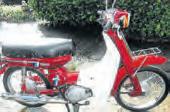
HONDA REBEL 1997, 250cc, Cruiser, 11,000 miles, MoT April 2023, very nice motorcycle Tel. 07439 53920.

BMWR650LS 1983, immaculate condition, contact for more info £3750 Tel. Roy 07789 903590.
WOLSELEY 1.5 saloon, 1964, 71450 miles, free t&t, ready to drive, £6500, will take classic bikes p/x, cash difference paid if required. Tel. Pete 01905 21667; 07966 178348.
HONDA CB500S 2001, condition, good new tyres, battery, chain, serviceforClassicTT,exchangefor lighter bike about 200cc to heavy now Tel. 01843 295518. Kent.
KYMCO X-CITING 2021, blue, showroom condition, 400cc maxi scooter, 36BHP model, light summer use, new scooter forces sale, fsh 4999 miles, garaged, mega comfy, £3999. Tel. 07784 499299. South Yorkshire.
MZTS250/1 Super 5, 1980, nice standard bike, in good useable condition, historic vehicle, V5 so tax & MoT free, recent new tyres, brakes and silencer, classic two stroke fun, £1750 ono Tel. 07771 834069. West Yorkshire.
ROYAL ENFIELD Meteor 350
Supanova, Stella Brown, genuine RE touring screen, seat, backrest and sumpguard, 72 plate (reg’d Sept 22) manufacturers warranty till Sept 25, 2, keys, owners manual/service book, bike has been virtually unused since purchase (12 miles), bike is in brand new condition, £3300 Tel. 01513 345927.
TRIUMPH BONNEVILLE T120R, 1970, 650cc, vgc for a 52 year old bike, matching frame and engine numbers, blue/silver, runs well, photo by phone, £7750 ono Tel. 07887 674467. Hants.
TRIUMPH 744cc, 1979, ORIV 396T, very fast, no leaks, drive away, £4750. Tel. 07799 754761. Lancashire.
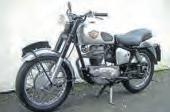




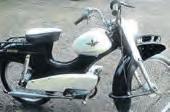
TRIUMPH BONNEVILLE 1977, Limited Edition, T140 with factory certificate, as new, Silver Jubilee model, previous MoTs and tax discs, only 7517 miles from new, twin discs, electronic ignition, offered from a private collection, photos available, free delivery arranged, £7950 Tel. 01723 372219. North Yorkshire.
YAMAHA FJR1300 2003, red, low mileage under 10,000 miles, a future collectors bike, great condition, only ridden in good weather, MoT to June 2023, £4500 ono Tel. Cornwall.
HARLEY-DAVIDSON new pair of brake discs, front disc zodiac 235473, rear disc PFM HD002, £70 the pair. Sportster chrome beltguard, £20. Avon Venom rear tyre like new 150-80-16, £30.
Honda CX/GL 500-650 Haynes Manual, £7. Hendler ‘new’ handlebars 3/4, £30 can send pictures Tel. 07704 343331.
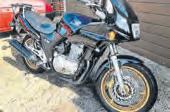
Stockport.
HONDA CMX500 Rebel, Puig screen, new boxed, £50. 1” heated grips, new boxed, £25 Tel. 01539 725198. Cumbria. Email. roger.harris1@sky.com
KAWASAKI ZZR600D 199093, full body plastics, f/guard, including fuel tank, all in good order, but sprayed orange, £100. Haynes Manuals for ZZR600 and Fireblade, 3 seperate models, £6 each Tel. 07758 515696. Lincs
Email. bobwoof41@gmail.com
Miscellaneous
ABBA BIKE STAND one person operation, with instructions and fixing kit for Kawasaki ZX6R Ninja, (fixing kits for other bikes available from ABBA), little used, £65. Tel. 01516 069983. Wirral.
BMW 1150GS Baglux tank cover, £15. BSA A10 kickstart quadrant, £25. Ariel gearbox, main shaft, £10. Ariel clutch centre + basket suit single, £20.
Honda radiator cover for NC700 unused. BSA Rocker box, £20. BSA A10 sump plate, £10. BSA metal tank badges for Lightning Thunderbolt, £20 Tel. 07968 390994. West Midlands.
EVERSURE CAR RAMPS pair, one owner from new, approx 32” long, 8” wide, 10” high, no damage, £30. Tel. 01299 266565. Worcs.
FLOWLINER ARMOUR COAT
fuel tank liner 625G & Flowliner B10 rust, never opened, brand new £66, now £33 collect or post Tel. 07787 525198.
LARGE BLACK LEATHER throw over pannier bags, just like new, will fit almost any bike, Adventure, Custom or Sports not tasselled or studded cost £90 bargain £45 ono Tel. 07988 149448. Lancs.
MOLTON STANDARD BICYCLE 1960s, maroon, 3 speed Sturmey Archer gears, 16” wheels, all complete, dry stored, ride/ restore, £70 Tel. 01299 266565. Worcs.
MOTORCYCLE JACKET
Alpinestars Denali Jacket, emerald/black, designed to keep riders warm in cold riding conditions, the Denali features extensive insulation in key areas, while the stretch panels on the side and sleeves provide an optimized fit as well as allowing high levels of movement on and off the bike Email. jandrimanda@ gmail.com
MOTORCYCLE JACKET Brando leather, classic BSA wings on rear top BSA Rocker, patches rocker jacket, studded belt, size medium large, can send pictures, £50 ono Tel. 07704 343331. Stockport.
MOTORCYCLE MAGAZINES from 1967-on free, would be nice to give a donation to a charity, 100s of them Tel. 01142 453009. Sheffield . SINGLE BIKE TRAILER with spare wheel, ramp, lights, quickly detachable box body, on 10” wheels Tel. 07786 298701. West Yorkshire.
YAMAHA FJR1300 2010
Bagster tank cover and Minea Tank bag, £45. Ventura light guard, new, £15. Pannier liner bags, new, £30 or £75 the lot Tel. 01225 435449. Wiltshire.
Selling your bike is FREE for private readers Choose one of the following methods: 1 ONLINE www.morebikes.co.uk 2 EMAIL freeads@morebikes.co.uk 3 POST MB Reader Adverts, Media Centre, Morton Way, Horncastle, Lincs LN9 6JR Classified































































































































































































































































































































































































































































































































































































































































































































































































































































 Alen Aldred’s lovely little Bridgestone TMX 100.
Paulo Baltazar’s much-loved Honda VFR. It’s a proper workhorse if we’ve ever seen one.
Don Jones has owned his super-reliable BMW R90S since 1979. He still rides it more than any of his other bikes.
Tony Schnauzer’s 1985 Honda Gold Wing looks like its ready for cruising the States.
Andrew Langdon’s not road legal but still awesome Honda VFR!
Rick O’s Triumph Thruxton R from 2019 bringing us a bit of modernretro goodness.
Grey Bear’s Aprilia Tuono Factory from 2008. We bet it sounds mean with that Akrapovic can.
Barry Tucker bought this Laverda Jota new way back in 1979 when he was just 20. Now they’re both 44 years older, but still have plenty of fun together.
Simon White’s Aprilia Dorsoduro 900. Lovely bit of kit that would put a smile on the face on any biker.
Alen Aldred’s lovely little Bridgestone TMX 100.
Paulo Baltazar’s much-loved Honda VFR. It’s a proper workhorse if we’ve ever seen one.
Don Jones has owned his super-reliable BMW R90S since 1979. He still rides it more than any of his other bikes.
Tony Schnauzer’s 1985 Honda Gold Wing looks like its ready for cruising the States.
Andrew Langdon’s not road legal but still awesome Honda VFR!
Rick O’s Triumph Thruxton R from 2019 bringing us a bit of modernretro goodness.
Grey Bear’s Aprilia Tuono Factory from 2008. We bet it sounds mean with that Akrapovic can.
Barry Tucker bought this Laverda Jota new way back in 1979 when he was just 20. Now they’re both 44 years older, but still have plenty of fun together.
Simon White’s Aprilia Dorsoduro 900. Lovely bit of kit that would put a smile on the face on any biker.




















































































































































































